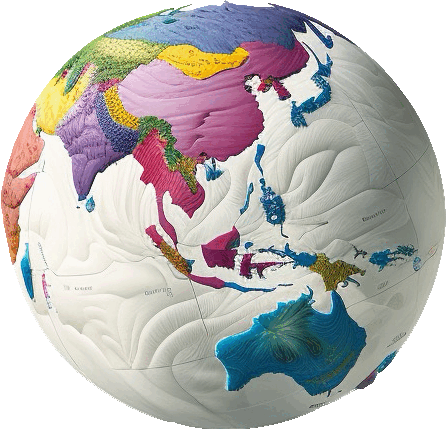 |
Your Australian World Expositions Connection
- Celebrating Brisbane's World Expo '88 and Australia at World Expositions -

Expo FAQs
Your Expo Questions Answered - from an Australian perspective
Your Expo Questions Answered - from an Australian perspective
Question
1.
What is a World Expo?
Related Questions: What was the first World Exposition?
What is the Bureau International des Expositions?
The word Expo - or Exposition - is used for a variety of circumstances from trade exhibits to conferences - and from tourism shows to meetings of special interest groups - often organised by a company or persons with similar interests - for commerce and/or education purposes - that need not be international - and need not be publicly funded.
Expositions can also be for good-will - where a Government issues invitations - to nations or corporations to exhibit their work at a singular venue - over a period of a few weeks to several months - for the purpose of engendering friendly ties between the host city/nation and participants - that may also facilitate other economic, cultural, and social ties.
Whilst previously Exhibitions and Trade Fairs were of a local scale - civic - regional - and so on, the rapid changes to transport, communications, and industry brought about by the Industrial Revolution led to the first "World Exposition" - where in the name of Progress and Peace - Victorian Great Britain - at the vanguard of these changes - invited the nations of the World to what is generally regarded as the first World Exposition - the "Great Exhibition of the Works of Industry of All Nations" - held at the built for the purpose Crystal Palace in London in 1851.
A great success, the Great Exhibition led other leading nations of the industrialised world to stage their own international Expositions, in essence becoming a type of stock-take of man's endeavours: unique to the host city, unique to the countries gathered there, and unique to the time and epoch of the Exposition itself - spearheading social change, interaction, and large-scale construction and development of the Exposition site and peripheral civic services adjoining the site and the host city. In this manner, Expo host cities since the Industrial Revolution have been able to re-design and re-create their most important boulevards, parks, and gardens; roads, rail and other transport infrastructure; as well as sell the city as a corporate and touristic entity in itself - ultra-modern, inter-national, and leading the times. Paris itself re-invented itself more than several times during hosting l'Exposition Universelle de 1867, 1878, 1889, as well as a joint hosting of the Olympic Games and a World Exhibition in 1900 - becoming known as the perpetual "Universal" City.
Hosting a World Exposition very soon became a much-sought after accolade for any developed nation - necessitating an over-all co-ordinating body to regulate the number of World Expositions - where they would be held and how often - as well as the rules governing participation - leading to the establishment by Diplomatic Convention in 1928 Paris, France, of the multi-lateral organisation the "Bureau International des Expositions", commonly known today by it's acronym - the "B.I.E.".
The chief role of the B.I.E. is to protect the interests of member nations, whether they be host or participant. A secondary measure is to regulate the frequency of World Expositions according to the proposed host city/member nation location - as well as to distance in time between each Exposition.
This does not mean that a non-member of the B.I.E. cannot host a World Exposition. There are several examples of large-scale international expositions since the formation of the B.I.E. where the B.I.E. has not been involved - for example the 1964-1965 New York World's Fair. In these cases, a special act of Parliament by the host government may cover many of the legal and regulatory functions that the B.I.E. would normally cover. However, also as in the case of the World's Fair of '64-'65, the B.I.E. can advise member nations to not support an Exposition that is hosted by a non-member of the B.I.E.
Membership
As at 2024 there are 183-member nations of the B.I.E. Only national-level governments can apply for membership - not state or city level governments. Any nation adhering to the 1928 Convention and the 1972 Protocol on International Exhibitions can apply for membership. The latest amendment to this protocol is of 31 May 1988.
Membership incurs a payable fee based on a sliding-scale according to U.N. Principles. The General Assembly of the B.I.E. - where general business is discussed - meets twice yearly - usually in June and December. Member nation delegates to the General Assembly are usually from the Diplomatic Corp - and usually are from the member nation Embassy in Paris - where the offices of the B.I.E. are located. The General Assembly is also the forum where bidding city candidates for future World Expositions present their case, and where the member nations of the B.I.E. place their vote - sometimes several rounds - for the seat of a future World Exposition.
The Paris Secretariat of the B.I.E. looks after the administrative functions of the Bureau, and is led by the Office of the Secretary-General, and includes a small Library. For further information on the B.I.E., visit the B.I.E. official web-site, https://www.bie-paris.org.
Note: In World Expositions parlance, the French translation into English of the words "Exposition" and "Universelle" refer to the English terms "Exhibition" and "International" - for example, as in "l'Exposition Universelle de 1889" - or- "the International Exhibition of 1889" (Paris). It is generally regarded that the word "Expo" - as an abbreviation - came to symbolise both French and English meaning of the words Exposition and Exhibition, from the 1967 World Exhibition onwards - or - as it was commonly known (in both French and English) - "expo 67" - an Exposition Universelle/World Exhibition which was held in French and English speaking Montreal, Canada. Correspondingly, the English usage has now become closer to the French - and International Exhibitions of the B.I.E. are now known in English as "World" or "International" Expositions or simply, "Expos". Nonetheless, officially today the B.I.E. is known in both French and English as the "Bureau International des Expositions".
The commonly used term for World Expositions in the United States of America is "World's Fair".
Related Questions: What was the first World Exposition?
What is the Bureau International des Expositions?
The word Expo - or Exposition - is used for a variety of circumstances from trade exhibits to conferences - and from tourism shows to meetings of special interest groups - often organised by a company or persons with similar interests - for commerce and/or education purposes - that need not be international - and need not be publicly funded.
Expositions can also be for good-will - where a Government issues invitations - to nations or corporations to exhibit their work at a singular venue - over a period of a few weeks to several months - for the purpose of engendering friendly ties between the host city/nation and participants - that may also facilitate other economic, cultural, and social ties.
Whilst previously Exhibitions and Trade Fairs were of a local scale - civic - regional - and so on, the rapid changes to transport, communications, and industry brought about by the Industrial Revolution led to the first "World Exposition" - where in the name of Progress and Peace - Victorian Great Britain - at the vanguard of these changes - invited the nations of the World to what is generally regarded as the first World Exposition - the "Great Exhibition of the Works of Industry of All Nations" - held at the built for the purpose Crystal Palace in London in 1851.
A great success, the Great Exhibition led other leading nations of the industrialised world to stage their own international Expositions, in essence becoming a type of stock-take of man's endeavours: unique to the host city, unique to the countries gathered there, and unique to the time and epoch of the Exposition itself - spearheading social change, interaction, and large-scale construction and development of the Exposition site and peripheral civic services adjoining the site and the host city. In this manner, Expo host cities since the Industrial Revolution have been able to re-design and re-create their most important boulevards, parks, and gardens; roads, rail and other transport infrastructure; as well as sell the city as a corporate and touristic entity in itself - ultra-modern, inter-national, and leading the times. Paris itself re-invented itself more than several times during hosting l'Exposition Universelle de 1867, 1878, 1889, as well as a joint hosting of the Olympic Games and a World Exhibition in 1900 - becoming known as the perpetual "Universal" City.
Hosting a World Exposition very soon became a much-sought after accolade for any developed nation - necessitating an over-all co-ordinating body to regulate the number of World Expositions - where they would be held and how often - as well as the rules governing participation - leading to the establishment by Diplomatic Convention in 1928 Paris, France, of the multi-lateral organisation the "Bureau International des Expositions", commonly known today by it's acronym - the "B.I.E.".
The chief role of the B.I.E. is to protect the interests of member nations, whether they be host or participant. A secondary measure is to regulate the frequency of World Expositions according to the proposed host city/member nation location - as well as to distance in time between each Exposition.
This does not mean that a non-member of the B.I.E. cannot host a World Exposition. There are several examples of large-scale international expositions since the formation of the B.I.E. where the B.I.E. has not been involved - for example the 1964-1965 New York World's Fair. In these cases, a special act of Parliament by the host government may cover many of the legal and regulatory functions that the B.I.E. would normally cover. However, also as in the case of the World's Fair of '64-'65, the B.I.E. can advise member nations to not support an Exposition that is hosted by a non-member of the B.I.E.
Membership
As at 2024 there are 183-member nations of the B.I.E. Only national-level governments can apply for membership - not state or city level governments. Any nation adhering to the 1928 Convention and the 1972 Protocol on International Exhibitions can apply for membership. The latest amendment to this protocol is of 31 May 1988.
Membership incurs a payable fee based on a sliding-scale according to U.N. Principles. The General Assembly of the B.I.E. - where general business is discussed - meets twice yearly - usually in June and December. Member nation delegates to the General Assembly are usually from the Diplomatic Corp - and usually are from the member nation Embassy in Paris - where the offices of the B.I.E. are located. The General Assembly is also the forum where bidding city candidates for future World Expositions present their case, and where the member nations of the B.I.E. place their vote - sometimes several rounds - for the seat of a future World Exposition.
The Paris Secretariat of the B.I.E. looks after the administrative functions of the Bureau, and is led by the Office of the Secretary-General, and includes a small Library. For further information on the B.I.E., visit the B.I.E. official web-site, https://www.bie-paris.org.
Note: In World Expositions parlance, the French translation into English of the words "Exposition" and "Universelle" refer to the English terms "Exhibition" and "International" - for example, as in "l'Exposition Universelle de 1889" - or- "the International Exhibition of 1889" (Paris). It is generally regarded that the word "Expo" - as an abbreviation - came to symbolise both French and English meaning of the words Exposition and Exhibition, from the 1967 World Exhibition onwards - or - as it was commonly known (in both French and English) - "expo 67" - an Exposition Universelle/World Exhibition which was held in French and English speaking Montreal, Canada. Correspondingly, the English usage has now become closer to the French - and International Exhibitions of the B.I.E. are now known in English as "World" or "International" Expositions or simply, "Expos". Nonetheless, officially today the B.I.E. is known in both French and English as the "Bureau International des Expositions".
The commonly used term for World Expositions in the United States of America is "World's Fair".
Question 2.
What is a Universal
Exposition?
Related Questions: What is an International Exposition?
What is a Registered (World) or Recognized (Specialised) Exposition?
What other categories of Expositions are there?
Related Questions: What is an International Exposition?
What is a Registered (World) or Recognized (Specialised) Exposition?
What other categories of Expositions are there?
World
Expositions
sanctioned by the B.I.E. fall into several
categories - some of which the official nomenclature
differs from the popular usage.
One of these examples is the difference between a
Universal -
or Class I - Exposition - which is officially
categorised as a "Registered Exposition" or "World
Expo" - and an International/Specialised - Class II
- Exposition - which is officially categorised as a
"Recognized Exposition", or "Specialised Expo".
"Registered" expositions are large-scale events - encompassing a broad theme applicable to all humanity. For example, recent Universal Expositions - 1958 Brussels - 1967 Montreal - 1970 Osaka and 1992 Seville had the themes of "Towards a More Human World" (coming out of the devastation of World War II), "Man and his World" (celebrating the 100th year of Canadian confederation), "Progress and Harmony" (first Exposition to be held in Asia), and "Discovery" (celebrating the fifth centenary of the discovery of the Americas). They are always of six months duration - where the Exposition Authority constructs the essential infrastructure - entrances/transport/electricity/communications and so on - however, leave the interior/exterior design and construction of pavilions to the participants themselves. In such case, the Universal Exposition not only becomes a competing ground for nations adhering to a common theme - but they also become a landmark event in state-of-the-art architecture - as participants are given free reign to design structures as they wish.
(There are also however some cases where the Authority constructs Pavilions to facilitate participation by nations that under normal circumstances would not be able to participate for financial reasons - i.e. in Spain's case for the 1992 Universal Exposition, in order to facilitate participation of every country from South America, a several-level Pavilion was constructed, titled "The Plaza of America".)
Thus, some of the 19th and 20th Century's most enduring architectural statements have been born of the World Expositions movement - from the massive cathedral of glass and cast-iron frame of the Crystal Palace of London in 1851; to the soaring Eiffel Tower of Paris of the 1889 Paris Universelle Exposition - the highest landmark in the World since the construction of the Pyramids of Giza; the grand lines and placid lakes of the majestic "White City" of the 1893 Chicago Columbian Exposition - celebrating the 400th Anniversary of the Discovery of the Americas; the 360-feet high monumental "Atomium" of the 1958 Brussels Exposition - a silver and steel rendition of the power of the Atom - marked up in size 150 billion times; the 20-story high "Unisphere" wire-frame World globe of the New York '64-'65 World's Fair; the "Tower of the Sun" by Taro Okamoto for the 1970 Osaka Exposition Japan; to the "Avenue of Europe" and the classical cube-dome-lake nexus of the Pavilion of Spain at the Universal Exposition of Seville, Spain in 1992 - celebrating the Fifth Centenary of the Discovery of the Americas.
"Registered" expositions are large-scale events - encompassing a broad theme applicable to all humanity. For example, recent Universal Expositions - 1958 Brussels - 1967 Montreal - 1970 Osaka and 1992 Seville had the themes of "Towards a More Human World" (coming out of the devastation of World War II), "Man and his World" (celebrating the 100th year of Canadian confederation), "Progress and Harmony" (first Exposition to be held in Asia), and "Discovery" (celebrating the fifth centenary of the discovery of the Americas). They are always of six months duration - where the Exposition Authority constructs the essential infrastructure - entrances/transport/electricity/communications and so on - however, leave the interior/exterior design and construction of pavilions to the participants themselves. In such case, the Universal Exposition not only becomes a competing ground for nations adhering to a common theme - but they also become a landmark event in state-of-the-art architecture - as participants are given free reign to design structures as they wish.
(There are also however some cases where the Authority constructs Pavilions to facilitate participation by nations that under normal circumstances would not be able to participate for financial reasons - i.e. in Spain's case for the 1992 Universal Exposition, in order to facilitate participation of every country from South America, a several-level Pavilion was constructed, titled "The Plaza of America".)
Thus, some of the 19th and 20th Century's most enduring architectural statements have been born of the World Expositions movement - from the massive cathedral of glass and cast-iron frame of the Crystal Palace of London in 1851; to the soaring Eiffel Tower of Paris of the 1889 Paris Universelle Exposition - the highest landmark in the World since the construction of the Pyramids of Giza; the grand lines and placid lakes of the majestic "White City" of the 1893 Chicago Columbian Exposition - celebrating the 400th Anniversary of the Discovery of the Americas; the 360-feet high monumental "Atomium" of the 1958 Brussels Exposition - a silver and steel rendition of the power of the Atom - marked up in size 150 billion times; the 20-story high "Unisphere" wire-frame World globe of the New York '64-'65 World's Fair; the "Tower of the Sun" by Taro Okamoto for the 1970 Osaka Exposition Japan; to the "Avenue of Europe" and the classical cube-dome-lake nexus of the Pavilion of Spain at the Universal Exposition of Seville, Spain in 1992 - celebrating the Fifth Centenary of the Discovery of the Americas.
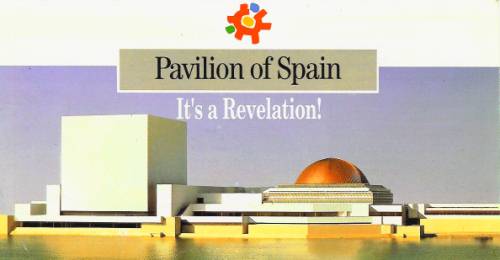 |
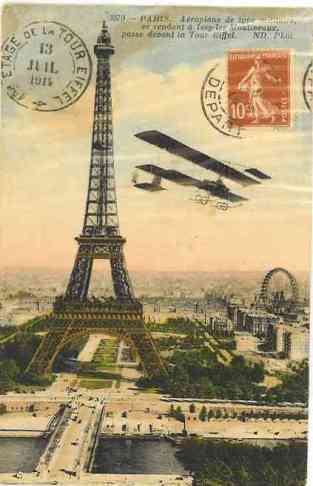 |
|
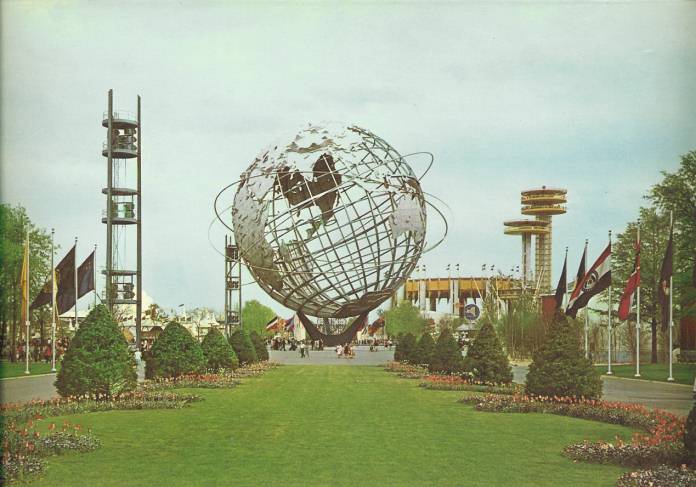 |
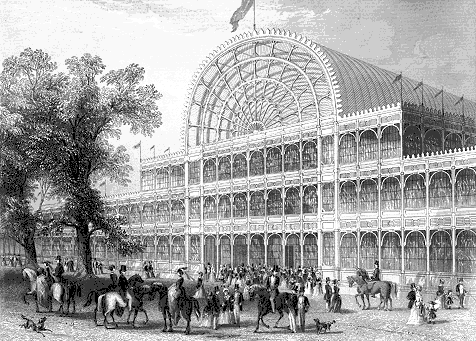 |
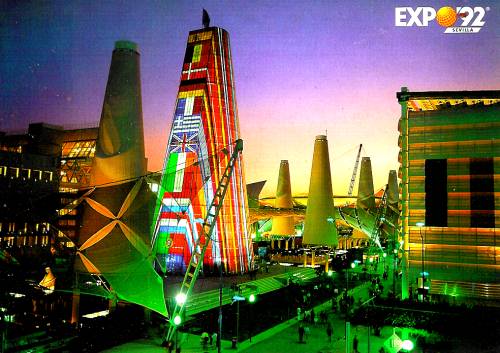 |
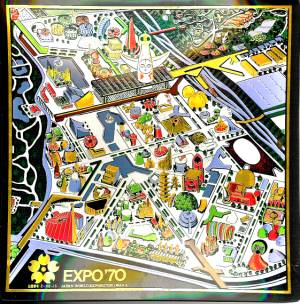 |
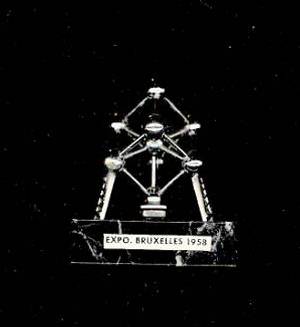 |
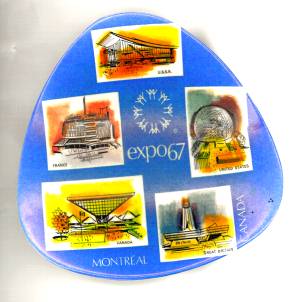 |
Surrounding images [clock-wise] pamphlet from the Pavilion of Spain, Universal Exposition of Seville 1992; postcard of the Eiffel Tower, Paris, from the 1889 Paris Universal Exposition;
postcard of the European Union Pavilion and Avenue of Europe, from the 1992 Universal Exposition of Spain; blue tray montage of pavilions from Expo '67 Montreal Canada;
model of the Atomium from the 1958 Universal Exposition of Brussels; tray montage of map of the Osaka Expo 70 site Japan; postcard of the Unisphere from the 1964/65 New York World's Fair.
Images courtesy of Celebrate 88.
"Recognized"
Expositions
- also commonly known as "International" or
"Specialised" Expositions - are of a smaller scale -
and last for a maximum of three months duration.
They differ chiefly from Registered Expositions in
that the theme is more specialised - like Brisbane's
of '88 - "Leisure in the Age of Technology" - AND -
in that the Expo Authority designs and constructs
the participating Pavilion structures as well as the
general Exposition infrastructure (also like
Brisbane's). In other words, the Expo Authority
designs Pavilion buildings of several sizes -
from which participants are able to choose sole
or joint occupancy. After the Authority has
completed the structures, participants then add
features to the exterior of their Pavilion space to
set it apart from others - i.e. decorative banners,
flags and ornaments. However, the essential building
characteristics for most Pavilions is the same. The
participant then works on filling-in the
content of the Pavilion space, addressing
the theme of the Exposition at the time, much as a
participant in a Registered Exposition would also
do.
World Expos - an acropolis/micropolis of icon structures many thousands times large - temples of international and state-of-the art architecture and expression - no doubt cost much more than Specialised Expositions. Corespondingly, they cannot be hosted too often - so in the competition to host a World Exposition member nations of the Bureau of International Expositions in Paris must decide:
(i) when was the last World Exposition held - in which part of the world; and,
(ii) when is the next proposed World Exposition?
Specialised Expositions generally run on a much smaller budget - not only due to reduced architectural and construction fees - but also due to the fact that they are mostly only three months in length.
Other Categories of Exposition
The B.I.E. also regulates applications for the position of "International Garden Exposition", or, "International Horticultural Exposition", according to approval by the International Association of Horticultural Producers - provided there is a two-year interval between each Exposition - and at least ten years between events held in the same country. Some recent International Garden Expositions are the 1990 Osaka International Garden Exposition (Japan), the 1999 Kunming (People's Republic of China) International Garden Exposition, and the 2023 Doha Qatar International Garden Exposition. Like World and Specialised Expositions, these Expositions are usually three to six months in length, however represent an international gathering of nations in the field of horticulture - where themed-gardens represent a participating nation's Pavilion. Follow this link from the B.I.E. for the complete list of horticultural expos: httpss://bie-paris.org/site/en/all-horticultural-expos
There is also one other category of Exhibition sanctioned by the B.I.E. - the Milan Triennale Exhibition of Decorative Arts and Modern Architecture - which has been held since 1923 and is generally 3-6 months in duration.
Question 3. Are Expositions held every four years like the Olympics?
Related Question: When is the next World Exposition?
Under the current rules of the B.I.E., World Expositions as a general rule of thumb are held every 5 years (i.e. years ending 0 and 5) - and Specialised Expositions may be held in the period between two World Expos. Recent examples of this are the 2012 Yeosu Specialised Exposition South Korea, the 2015 World Exposition Milano Italy, the 2017 Astana Specialised Exposition Kazakhstan, the 2020 Dubai World Exposition U.A.E., the 2023 Buenos Aires Specialised Exposition (cancelled) and the 2025 World Exposition Osaka Kansai Japan. The current rules also stipulate that Specialised Expo last for a maximum duration of 3 months.
At the beginning of the 20th century, however, the host city of an Olympic Games was also host city of a World Exposition at the same time twice in a row - for example, Paris 1900 and St Louis 1904. This pattern however has not repeated itself since that time.
The next World Exposition is to be held in Osaka, Japan, in 2025. The six-month Universal Exposition shall last from 13 April 2025 to 13 October 2025 - themed "Designing Future Society for Our Lives". Osaka is hoping to welcome 28 million visitors to Expo. Some 150 countries and 25 organisations will take part.
Visit the official Osaka Kansai Expo 2025 website at httpss://www.expo2025.or.jp/en/
World Expos - an acropolis/micropolis of icon structures many thousands times large - temples of international and state-of-the art architecture and expression - no doubt cost much more than Specialised Expositions. Corespondingly, they cannot be hosted too often - so in the competition to host a World Exposition member nations of the Bureau of International Expositions in Paris must decide:
(i) when was the last World Exposition held - in which part of the world; and,
(ii) when is the next proposed World Exposition?
Specialised Expositions generally run on a much smaller budget - not only due to reduced architectural and construction fees - but also due to the fact that they are mostly only three months in length.
Other Categories of Exposition
The B.I.E. also regulates applications for the position of "International Garden Exposition", or, "International Horticultural Exposition", according to approval by the International Association of Horticultural Producers - provided there is a two-year interval between each Exposition - and at least ten years between events held in the same country. Some recent International Garden Expositions are the 1990 Osaka International Garden Exposition (Japan), the 1999 Kunming (People's Republic of China) International Garden Exposition, and the 2023 Doha Qatar International Garden Exposition. Like World and Specialised Expositions, these Expositions are usually three to six months in length, however represent an international gathering of nations in the field of horticulture - where themed-gardens represent a participating nation's Pavilion. Follow this link from the B.I.E. for the complete list of horticultural expos: httpss://bie-paris.org/site/en/all-horticultural-expos
There is also one other category of Exhibition sanctioned by the B.I.E. - the Milan Triennale Exhibition of Decorative Arts and Modern Architecture - which has been held since 1923 and is generally 3-6 months in duration.
Question 3. Are Expositions held every four years like the Olympics?
Related Question: When is the next World Exposition?
Under the current rules of the B.I.E., World Expositions as a general rule of thumb are held every 5 years (i.e. years ending 0 and 5) - and Specialised Expositions may be held in the period between two World Expos. Recent examples of this are the 2012 Yeosu Specialised Exposition South Korea, the 2015 World Exposition Milano Italy, the 2017 Astana Specialised Exposition Kazakhstan, the 2020 Dubai World Exposition U.A.E., the 2023 Buenos Aires Specialised Exposition (cancelled) and the 2025 World Exposition Osaka Kansai Japan. The current rules also stipulate that Specialised Expo last for a maximum duration of 3 months.
At the beginning of the 20th century, however, the host city of an Olympic Games was also host city of a World Exposition at the same time twice in a row - for example, Paris 1900 and St Louis 1904. This pattern however has not repeated itself since that time.
The next World Exposition is to be held in Osaka, Japan, in 2025. The six-month Universal Exposition shall last from 13 April 2025 to 13 October 2025 - themed "Designing Future Society for Our Lives". Osaka is hoping to welcome 28 million visitors to Expo. Some 150 countries and 25 organisations will take part.
Visit the official Osaka Kansai Expo 2025 website at httpss://www.expo2025.or.jp/en/
Question 4.
Who is responsible for
Australia's representation at World Expositions?
Responsibility for the Australian Commonwealth Government representation at World Expositions has been the portfolio of several different Government Departments.
Previous to Federation in 1901, each separate Australian colony chose on an individual basis how they were represented at a World Exposition.
In recent years Australian representation at a World Exposition has been the responsibility of the Australian Exhibitions Organisation - a specialised Government unit for such purposes (now disbanded), the Commonwealth Government Department of Tourism, and since 1996 the Commonwealth Government Department of Foreign Affairs and Trade.
Question 5. When did Australia sign the Convention relating to International Exhibitions?
Australia signed the Convention relating to International Exhibitions in 1935 - shortly after the formation of the B.I.E. in Paris in 1928 - however rescinded it's membership in 1945 - following same decision by the United Kingdom and Canada.
As noted in work by Professor Peter Carroll, the Australian Prime Minister Sir Robert Menzies comment on this was that Australia's special interests with regards to the promotion of trade are better served by not being limited to the Convention. After some opposition and lobbying, however, Australia re-joined the Convention in 1972 with the Whitlam Government's vote into power, with a subsequent decision in 2015 to leave the B.I.E. and assess Australia's hosting and representation at World Expositions on a 'merit-based' and 'case-by-case' basis, citing financial pressures. Note here summary from Parliament of Australia website as at 12 August 2015 - httpss://www.aph.gov.au/-/media/02_Parliamentary_Business/24_Committees/244_Joint_Committees/JSCT/2015/Report155/Chapter_2.pdf?la=en&hash=A90C5560774E422654EA0F117BF3DB8569ADB540
As at 2024 Australia is still not a member of the B.I.E. although this does not impact upon Australia's ability to be represented at World Expositions.
Responsibility for the Australian Commonwealth Government representation at World Expositions has been the portfolio of several different Government Departments.
Previous to Federation in 1901, each separate Australian colony chose on an individual basis how they were represented at a World Exposition.
In recent years Australian representation at a World Exposition has been the responsibility of the Australian Exhibitions Organisation - a specialised Government unit for such purposes (now disbanded), the Commonwealth Government Department of Tourism, and since 1996 the Commonwealth Government Department of Foreign Affairs and Trade.
Question 5. When did Australia sign the Convention relating to International Exhibitions?
Australia signed the Convention relating to International Exhibitions in 1935 - shortly after the formation of the B.I.E. in Paris in 1928 - however rescinded it's membership in 1945 - following same decision by the United Kingdom and Canada.
As noted in work by Professor Peter Carroll, the Australian Prime Minister Sir Robert Menzies comment on this was that Australia's special interests with regards to the promotion of trade are better served by not being limited to the Convention. After some opposition and lobbying, however, Australia re-joined the Convention in 1972 with the Whitlam Government's vote into power, with a subsequent decision in 2015 to leave the B.I.E. and assess Australia's hosting and representation at World Expositions on a 'merit-based' and 'case-by-case' basis, citing financial pressures. Note here summary from Parliament of Australia website as at 12 August 2015 - httpss://www.aph.gov.au/-/media/02_Parliamentary_Business/24_Committees/244_Joint_Committees/JSCT/2015/Report155/Chapter_2.pdf?la=en&hash=A90C5560774E422654EA0F117BF3DB8569ADB540
As at 2024 Australia is still not a member of the B.I.E. although this does not impact upon Australia's ability to be represented at World Expositions.
Question 6. How many World Expositions has Australia hosted?
World Expositions in this question shall be determined by their pre- or post- B.I.E. formation.
Sydney first hosted a World Exhibition in 1879-1880 (17 October - 20 April), then was followed by Melbourne in 1880-1881, Adelaide in 1887, Melbourne again in 1888-1889 (celebrating the Centennial of European Settlement), Brisbane (1897), and then Hobart (1894).
Since the formation of the B.I.E. Australia has hosted only one exposition - the 1988 World Exposition in Brisbane, more commonly known as World Expo '88. World Expo '88 was classified as a Class II - or International Specialised Exposition, and ran from 30 April 1988 - 30 October 1988 - the largest event of Australia's Bicentennial of European Settlement calendar.
In total Australia has hosted seven World Expositions.
|
Question 7.
The Paris
Universelle Exposition
of 1889 is
well
remembered
for Gustav Eiffel's
contributions - the
Eiffel
Tower.
What icons does
Australia have from her
World Expositions experience?  Image © Celebrate 88 (2024) Most notable is the Melbourne Royal Exhibition Building - originally built for the 1880-1881 Melbourne Exhibition - and also used for the 1888-1889 Melbourne Centennial Exhibition. The Exhibition Building, with it's soaring dome and vast un-impeded beams, was also the site of the proclamation of the Commonwealth of Australia in 1901, and also the site of celebrations pertaining to the Centennial of the founding of the Commonwealth of Australia in 2001. The Royal Exhibition Building now adjoins the multi-million dollar Melbourne Museum, and was recognized as a World Heritage Bulding by UNESCO in 2004. The UNESCO web-site has further details. https://whc.unesco.org/pg.cfm?cid=31&id_site=1131 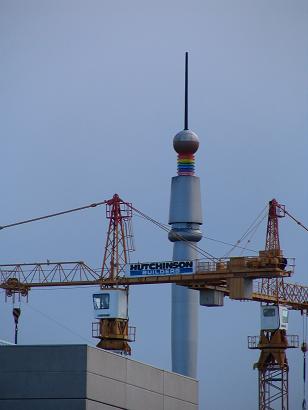 The
symbol tower from Brisbane's World Expo '88 -
'Night Companion' - or - the 'Skyneedle' as it
was also called - standing 88-metres tall - was
an enduring symbol of the arrival of the
Exposition - and, located adjacent to the Ken
Done-created Australia Pavilion Entrance
AUSTRALIA letters art installation (another
famous icon of the Expo) - the bronze disc
circular canopy roof above the tower base
quickly became the popular rendezvous at the
Expo - by night or by day. The $AUD 4.0 million
tower was based on a sculpture by famous
Melbourne artist Robert Owen/interpreted by
Charles Sutherland, and during the Expo it's
powerful xenon light beam surveilled the
Brisbane horizons up to 60km away every night
whilst allowing for non-interference with the
Brisbane Airport Tower. The
symbol tower from Brisbane's World Expo '88 -
'Night Companion' - or - the 'Skyneedle' as it
was also called - standing 88-metres tall - was
an enduring symbol of the arrival of the
Exposition - and, located adjacent to the Ken
Done-created Australia Pavilion Entrance
AUSTRALIA letters art installation (another
famous icon of the Expo) - the bronze disc
circular canopy roof above the tower base
quickly became the popular rendezvous at the
Expo - by night or by day. The $AUD 4.0 million
tower was based on a sculpture by famous
Melbourne artist Robert Owen/interpreted by
Charles Sutherland, and during the Expo it's
powerful xenon light beam surveilled the
Brisbane horizons up to 60km away every night
whilst allowing for non-interference with the
Brisbane Airport Tower.The tower - now some 500-metres from it's original site - is now owned by hairdressing empire magnate Steve 'Stefan' Ackerie, of Stefan Hairdressing, and is now a prominent South Brisbane landmark. The eye of the revolving light beacon in the tower - viewable in above image just below the Stefan rainbow rings - no longer lights up the Brisbane skylines as it did every evening during World Expo '88. [Photos ©
Celebrate 88][Above] The Stefan Skyneedle as
viewed from the Queensland Cultural Centre
Overpass
prefaced by the on-going site re-development at South Bank - the former Expo site. [Image Right] This shows the tower closer - with the corrugated bronze circular canopy roof near the tower base partially obscured.The tower was de-constructed into several components before re-location at it's new site. |
 |
Question 8. Who were the principal corporate participants of World Expo '88?
There were three levels of corporate participation at World Expo '88 - Corporate Exhibitors; Corporate Suppliers; and Corporate Sponsors.
Corporate Exhibitors at World Expo '88 - those corporations that operated a Pavilion related to their specific business on the Exposition site were:
Australia Post - 'The Australia Post Pavilion'
Australian Airlines - 'The Australian Airlines Exhibit', located in The Plaza
Cadbury Schweppes Pty Ltd - 'The Cadbury Confectionary Pavilion'
Communities of Australia Pavilion - 'The Communities of Australia Pavilion'
Ford Motor Company of Australia Limited - 'The Ford Pavilion'
Fujitsu Australia Limited - 'The Fujitsu Pavilion'
IBM Australia Limited - 'The IBM Pavilion'
Japan External Trade Organization - 'The Japan Technoplaza Pavilion'
(hosting the following Japanese Organizations)
JETRO - 'Karakuri-Ningyou'
Leisure Development Centre of Japan - 'Children's Maze'
Idemitsu Kosan Co Ltd - 'Friendship Capsules'
Hitachi Ltd - 'Techno Forest'
Office of Economic Development For The City of Brisbane
Pavilion of Promise Ltd - 'The Pavilion of Promise'
Primary Industries Pavilion Ltd - 'Silo in the City - The Primary Industries Pavilion'
Royal Australasian College of Surgeons - 'Surgery: The Art'
Qantas Airways Limited - 'The QANTAS Light Fantastic Night Parade' (6.30pm daily)
Queensland Newspapers Limited - 'The Queensland Newspapers Pavilion'
Queensland Teachers Credit Union Limited - 'The Queensland Teachers Credit Union Pavilion'
'Service Clubs of Australia' - Zonta, Rotary, Lions, Quota - located in 'Entertainment House'
Suncorp Building Society - 'The Suncorp Pavilion'
Telecom Australia - over 50 'Telecom Expo Info' electronic information booths throughout the Expo site, each hosting several interactive screens under one roof
Univations - Universities of Queensland - 'The Univations Pavilion'
Universal Telecasters Qld Limited -'The Universal Telecasters Pavilion'
Corporate Suppliers - those corporations which supplied goods and services to World Expo '88:
APD Snack Foods Pty Limited
Annand & Thompson Pty Ltd
ATCO Industries (Aust) Pty Ltd
Australia Post
Australian Airlines
Australian Consolidated Press Limited
Australian United Foods
B & W Cabs
Berkeley Cleaning Group Pty Ltd
Best Available Seating Service (NSW) Pty Ltd
BP Australia Limited
Bisley (Qld) Pty Ltd
Brisbane Computer Supplies Pty Ltd
Brother Industries (Aust) Pty Ltd
Budget Chauffeur Drive
Bunzl Australia Limited
Cadbury Schweppes Pty Ltd
Campbell Brothers Limited
Coca-Cola Bottlers (Brisbane) Ltd
Commonwealth Employment Service
The Commonwealth Industrial Gases Ltd
Cordon BleuStaff Agency
Datapoint Corporation Pty Ltd
Drake Personnel Limited
Evans Evans Flags Pty Ltd
Evans Deakin Industries Limited
Ford Motor Company of Australia Ltd
Fuji Photo Film Co Pty Ltd (Hanimex Pty Ltd)
Gold Coast Radio Broadcasting Co Pty Ltd
Greyhound Australia Pty Ltd
Hastings Deering Limited
Hattori (Australia) Pty Ltd
Heyden Spike Limited
Hitachi Australia Limited
IBM Australia Limited
K.M.G. Hungerfords
The Kona Coffee Company
Lansing Australia Pty Ltd
Lend Lease Interiors Pty Ltd
LEP International Pty Ltd
Finney Bryce Transport Pty Ltd
Lorraine Martin Personnel
Mater Misericordiae Public Hospital
National Car Rentals
Natures Alternative (Aust) Pty Ltd
Nettlefold Advertising Pty Ltd
New Zealand Breweries Ltd
O' Donnell Griffin
Price Waterhouse Urwick
Q.U.F. Industries Limited
Qantas Airways Limited
Queensland Independent Wholesalers Ltd
Queensland Newspapers Pty Ltd
Queensland Regional Dailies
Radio 4AK
Rank Xerox (Aust) Pty Ltd
Rydge Visual Communications
Signtronics Australia Pty Ltd
Slade Consulting Group Pty Ltd
South East Queensland Electricity Board
Southern Pacific Hotel Corporation Limited
Stereo FM Brisbane Limited
Suncorp Building Society
Supergrasse International Pty Ltd
Syme Electronic Communications Pty Ltd (AAV Australia)
TNT Security (Qld) Pty Ltd
Telecom Australia
Thomas Hardy & Sons Limited
Universal Telecasters Qld Limited
Wesgo Communications Pty Ltd (Stereo 4KQ Brisbane)
Westpac Banking Corporation
Wormald Fire Systems
Corporate Sponsors - corporations that sponsored a World Expo 88 facility or category of public entertainment:
A.N.A. Japan : the Expo South Monorail Station, and one of the four Expo Monorails
Australian Consolidated Press Limited "The Bulletin Club"
BP Australia Limited : 'The BP Australia Water Ski Spectacular'
C. Itoh & Co (Aust) Ltd : 'The Vulture Street Gate'
Conrad International Hotel
Fosters Breweries Ltd. : one of the four Expo Monorails
Fuji Photo Film Co Pty Ltd (Hanimex Pty Ltd) : three (3) on-site 1 Hr Mini-Labs
Iberia Airlines of Spain : one of the four Expo Monorails
Johnson & Johnson Australia Pty Ltd
Metropolitan Permanent Building Society
Qantas Airways Limited : 'The QANTAS Light Fantastic Night Parade' (daily at 6.30 p.m.)
Ray White Real Estate Ltd. : the Expo North Monorail Station
Syme Electronic Communications Pty Ltd (AAV Australia)
Westpac Banking Corporation : one of the four Expo Monorails
Question
9.
What
was the official title of the Expo? What type of
expo was it?
What was the official theme, logo, theme song and mascot?
What was it that made the 1988 Brisbane World Exposition special?
What was the cultural program like? What are the enduring icons of the 1988 World Exposition?
How large was the Expo and how many official participants were there? Who were they?
Related Questions: What were the official opening and closing dates of the Exposition? Who officially opened World Expo '88?
How many visits were made to World Expo '88? What was the average daily attendance figure?
What was the highest single day visitor figure? What was the budget for World Expo '88?
What was the financial benefit to the Queensland economy? How much did it cost to purchase a day ticket?
Who was the Commissioner-General of World Expo '88 and what was the office's role?
Who was the World Expo '88 Authority? How many people were employed at World Expo '88?
The official title of the Exposition was the "International Exposition on Leisure in the Age of Technology, Brisbane, Australia, 1988." The common title was "World Expo 88".
World Expo 88 was registered as a Special Exposition by the Bureau International des Expositions (B.I.E., Paris) on 5 December 1983. It was declared an Official Bicentennial Event by the Australian Bicentennial Authority (ABA) and was the largest event of Australia's Bicentennial Year in 1988 - celebrating 200 years of European Settlement.
The official theme of World Expo '88 was "Leisure in the Age of Technology", which was articulated into three sub-themes, that international, national, and corporate participants were free to interpret in their Pavilion and/or other displays:
. Leisure - The Universal Pastime
. Technology - Creating and Created for Leisure
. Leisure and Technology - The Future Together
World Expo '88 had two interchangeable official logos.

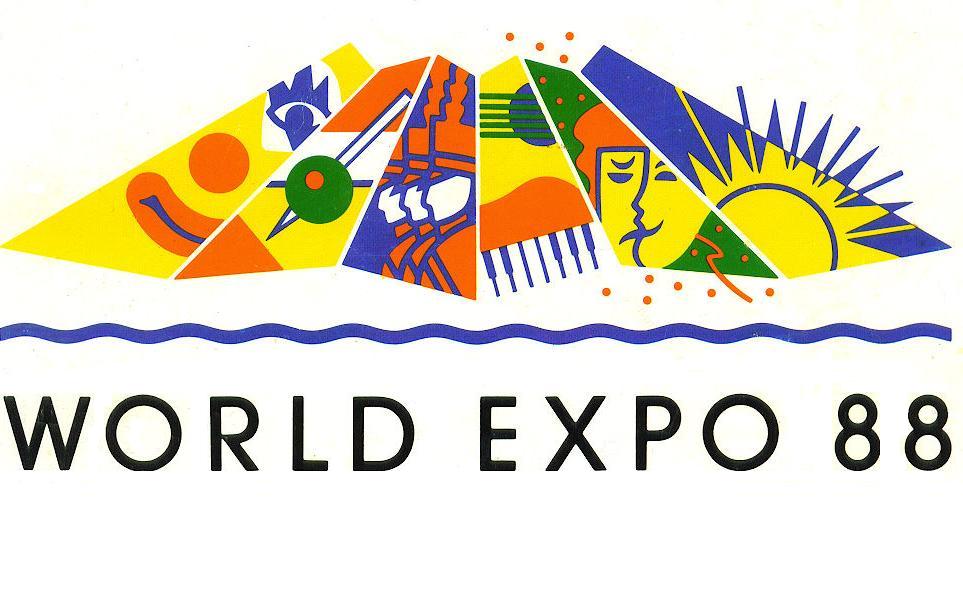
The globe-logo [L] featured the design of two boomerangs, side-by-side, representing the letter 'X', joined with a stylized 'P' with the numerals '88' in the centre, representing "PO 88" - as in 'eXPO 88' - superimposed on frame-wire globe. The green-and-gold colour scheme represent the official sporting colours of Australia.
The sun-sails logo [R] featured a relief image of the Exposition iconic 'sun-sails' in yellow, above a wavy-line border - representing the Expo's situation on the banks of the Brisbane River. Each sun-sail segment featured a different motif - representing the arts and entertainment featured at World Expo '88 - [from left to right] - circus; the visual arts; marching bands; the performing arts; theatre; 'all under the Queensland sun'. (The State of Queensland is familiarly known as 'The Sunshine State'.)
The official theme song of World Expo '88 was "Together, We'll Show the World", and was written and composed by Frank Miller and Carol Lloyd.
The official mascot was 'Expo Oz' - a fun, anime depiction of an Australian Platypus - and was designed by Bob Moore of Disney's Imagineering Division. Some images of Expo Oz appear below.
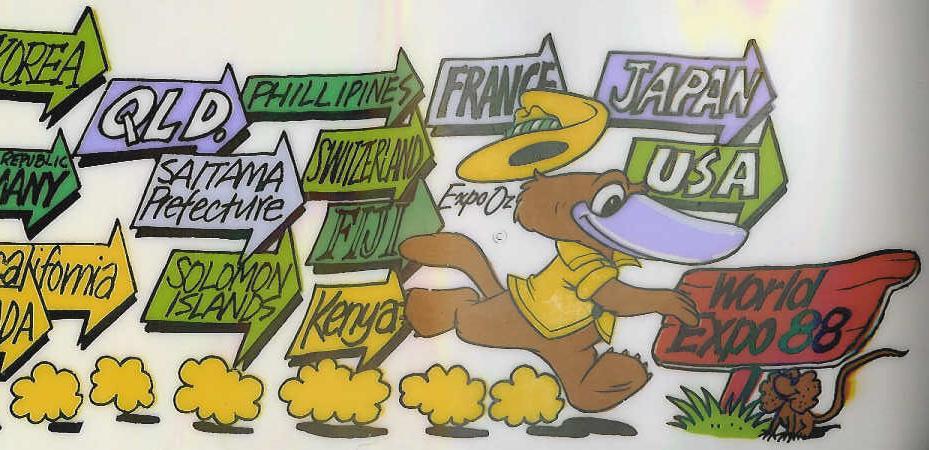

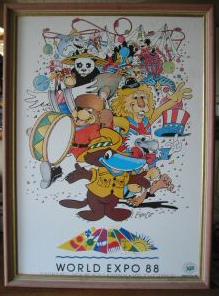
There are several factors that make the 1988 Brisbane World Exposition stand out:
. The first and only World Exposition to be held by Australia - and in the Southern Hemisphere - in the 20th Century.
. The largest event of Australia's 200th Anniversary of European Settlement 1788-1988 - and the largest event in Australia's history.
. An intimate 40-hectare river-side CBD venue, with the largest canopied area in the World - 8 massive tension membrane sunsail canopies soaring high above.
. Representation by 52 government participants - 36 nations - and all the major Australian States and Territories.
. Over 16 million visits - more than double the estimated original figures - and equivalent to the population of Australia at the time.
. Over 100 corporate exhibitors, sponsors, and suppliers - one of the most extensive corporate presences for any World Exposition.
. The largest Australian art commission for the 88-metre high symbol tower of the Exposition - 'Night Companion'.
. A $AUD 9 million budget of over 150,000 planted and site-scaped trees, shrubs and flowers - made the Expo a micropolis garden in the centre of the City
. One of the world's largest and most expensive open-air public art programs - $AUD 34 million of over 100 Australian and internationally renowned works, including 16 works especially commissioned for the Expo, including Pomodoro, Moore, Frink, Hudson, Tinguely, Graetz, Grubb, Oakes, Johns, and Cole.
. 88 'Human Factor' plaster-of-paris 'still lfe' figures capturing the whimsy of day-to-day life - from surf lifesavers to tourists, and trolley-lady's to sailormen.
. An extensive on-site and off-site $AUD 44 million entertainment program - over 14,000 live performances over 184 days - featuring the best of Bicentennial Australia international and local talent - from rock'n'roll to classical music; comedy to theatre; musicals to talent shows - from the 10,000 seater River Stage, to the European fair fun of the 3,000 capacity 'Piazza'; from the intimate 500-seater Amphitheatre to the lines, queues and boulevards of the Expo where a comic, clown or comedian was found at every corner!
. Emergent technologies including High Definition TV (Japan), text internet (Switzerland), solar cars (Australia), amphibious 4WDs (Federal Republic of Germany), multi-lingual touch-screen interface multi-media computer information booths (Telecom Australia), moving theatrette vehicle simulators (Britain/Japan), baseball and golf computer simulators (U.S.A.), personal hydrofoils (Yamaha, Japan), computer-3.5inch disk programmable Kawai pianos (Japan), 1 Hour Photo Film developing booths (Fuji Film), electronic computer newspapers (News Corporation 'Qld News Pavilion'), computer pen pals (Australia Post), and artificial snow makers (Switzerland).
. The last representation by the U.S.S.R. and the Federal Republic of Germany at a World Exposition
. The first Government co-ordinated yet private enterprise funded World Exposition.
An Australian Bicentennial and World Expositions Cultural Program for the City - and Expo - un-paralleled
In conjunction with the off-site 'World Expo on Stage' program at the then newly launched Queensland Performing Arts Complex, and special travelling international exhibitions arranged for the Australian Bicentennial at the adjoining Queensland Art Gallery, Queensland Musem and State Library - all adjoining the Expo site - Brisbane really did become the 'World on Stage'. Some of the top names and highlights were:
Icons of World Expo '88 that represent the Exposition's popular culture - as an Australian Exposition, as a 1788-1988 Bicentennial Event, and as the 1988 World Exposition.
Firstly the spectacular City RiverSide setting for the 10,000 capacity River Stage and World Globe - with Australia in the centre.
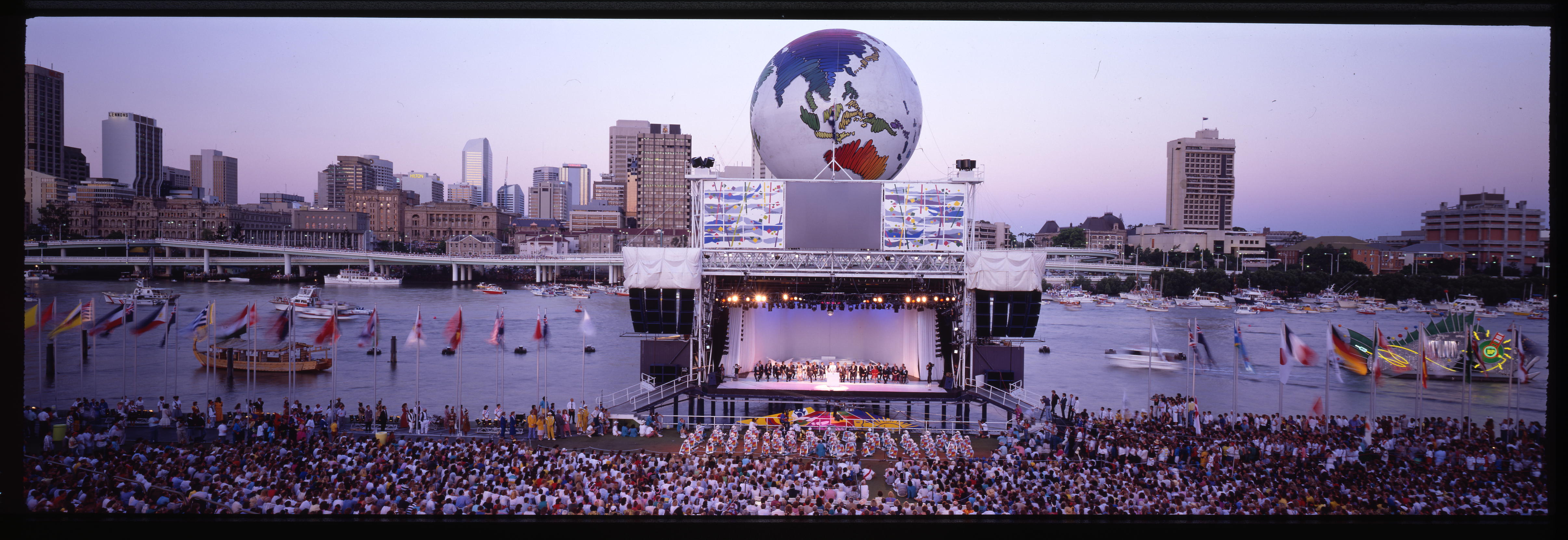

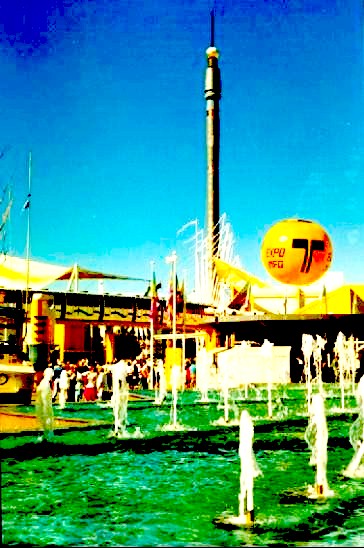
After it's successful re-development into the World Expo '88 site, World Expo '88 played host to 36 national-level governments, 12 state/territory-level governments, 2 city-level governments, 2 multi-lateral organisations (the U.N. and the European Community), 18 community-level representations, 48 corporations, and 2 thematic pavilions.
The 36 national governments were:
Australia
Brunei Darussalam
Canada
People's Republic of China
The Cook Islands
Cyprus
Fiji
France
Federal Republic of Germany (last representation at a World Exposition)
Great Britain
Greece
The Holy See (Vatican)
Hungary
Indonesia
Italy
Japan
Kenya
Republic of Korea
Malaysia
Nepal
New Zealand
Pakistan
Papua New Guinea
Philippines
Singapore
Solomon Islands
Spain
Sri-Lanka
Switzerland
Thailand
Kingdom of Tonga
United States of America
U.S.S.R. (last representation at a World Exposition)
Western Samoa
Vanuatu
Yugoslavia
The 12 regional/state/territory governments were:
[Australia]
Queensland
New South Wales
Australian Capital Territory
Victoria
Tasmania
South Australia
Western Australia
Northern Territory
[Japan]
Saitama Prefecture (Sister-State of Queensland)
[United States of America]
Alaska
California
Hawai'i
The 2 City-level Governments were:
Kobe City, Japan (Brisbane's Sister-City)
Office of Economic Development of the City of Brisbane
The Community-level Representations were:
The Art of Central Australia Exhibit
The Communities of Australia Exhibit, incorporating
Greater Brisbane, Gold Coast/Albert Shire, Sunshine Coast, Toowoomba and the Golden West, Darling Downs/Southern Border, Whitsundays,
Gulf Savannah, Mackay, Outback Queensland, Cairns/Mulgrave, Bundaberg, Mt Isa, Sugar Coast/Burnett, Rockhampton, Magnetic North (Townsville
Region), and Lismore/Holiday Coast (NSW)
The Indigenous Communities of Queensland Exhibit, incorporating displays of visual and performing arts of Queensland and Torres Strait Islander culture
The 2 multi-lateral organisations were:
The United Nations
The European Community
The 48 Corporate Participants were:
[* indicates Pavilion]
[> indicates shared Pavilion]
[! indicates Sponsor of Exposition Entertainment or Services]
[^ indicates open air exhibit]
! A.N.A. Japan - Expo South Monorail Station, and one of the four Expo Monorails
> The Australian Airlines Exhibit (The Plaza)
! Australian Consolidated Press Limited - "The Bulletin Executive Club, at World Expo '88"
> The Australian Opal Mining Showcase Exhibit
* The Australia Post Pavilion
! The BP Australia Water Ski Spectacular
* The Cadbury Confectionary Pavilion
! C. Itoh & Co (Australia) Ltd - The Vulture Street Gates
> Comet Express - TNT (The Plaza)
! Conrad International Hotel
! The 'FM-104' RiverStage Control Centre - Riverstage Entertainment and laser shows
* The Ford Pavilion
! Fosters Australia Ltd. - one of the four Expo Monorails
! Fuji Photo Film Co Pty Ltd (Hanimex Pty Ltd) - official supplier of film and cameras - three (3) on-site 1 Hr Mini-labs, as well as the Photographic Media Centre.
* The Fujitsu Pavilion
> Hitachi Ltd (Japan Technoplaza)
! Iberian Airlines of Spain - sponsor of one of the four Expo Monorails
* The IBM Pavilion
> Idemitsu Kosan Co Ltd (Japan Technoplaza)
> The India Centre (The Plaza)
* The Japan External Trade Organization (The Japan Technoplaza)
! Johnson & Johnson Australia Pty Ltd
> Leisure Development Centre of Japan (Japan Technoplaza)
> Lions Service Club (The Service Clubs of Australia Pavilion - located at Entertainment House)
> LITS Tour and Travel Centre (The Plaza)
> Mater Misericordiae Hospital (The Plaza)
! Metropolitan Permanent Building Society
> The National Campaign Against Drug Abuse 'The Drug Offensive' (The Plaza)
^ The NASA Exhibit - featuring large-scale models of the Apollo Missions, and the Space Shuttle
* The Pavilion of Promise
! The QANTAS Light Fantastic Night Parade (daily at 6.30 p.m.)
* The Queensland Maritime Museum Pavilion
* The Queensland Newspapers Pavilion
* The Queensland Teachers Credit Union Pavilion
> Quota Service Club (The Service Clubs of Australia Pavilion - located at Entertainment House)
! Ray White Real Estate Ltd., sponsor of the Expo North (Melbourne Street) Monorail Station
> Rotary Service Club (The Service Clubs of Australia Pavilion - located at Entertainment House)
> The Royal Australasian College of Surgeons Exhibit 'Surgery: The Art' (The Plaza)
* The 'Silo in the City' - Primary Industries Pavilion
^ The 'Sensus' Play Area - sponsored by Suncorp Building Society
* The Suncorp Pavilion
! Syme Electronic Communications Pty Ltd (AAV Australia)
! Telecom Australia 'Expo Info' booths - over 50 booths located throughout the Expo site, with easily recognizable balloons and several interactive screen terminals
* The Univations Pavilion (Universities of Queensland)
^ The Universal Studios Exhibit - featuring the car 'KITT' from the TV series 'Knight Rider'
* The TV0 Pavilion - Network 10 Australia - Universal Telecasters
! Westpac Banking Corporation - banking facilities and foreign exchange; Sponsor of one of the four Expo Monorails
> Zonta Service Club (The Service Clubs of Australia Pavilion - located at Entertainment House)
The 2 Thematic Pavilions were:
Captain Cook, Navigator
The Magna Carta Pavilion
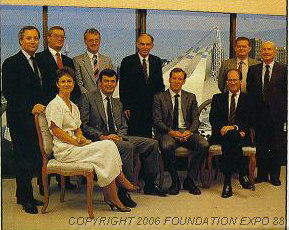
A total of 24, 000 persons were accredited by World Expo '88.
Question 10. How can I help Foundation Expo '88?
Attend one of our bi-annual meetings - held on the anniversary days of the opening and closing ceremonies - 30 April and 30 October.
Write a passage about your day at World Expo '88. What can you remember? What was your favourite pavilion? What was your most memorable experience?
Send a copy of some of your favourite Expo '88 photographs for addition on the Foundation 'Photos' and 'Pavilions' pages.
Suggested Further Reading - References
Bureau of International Exhibitions, https://www.bie-paris.org (26 October 2005)
Commssioner General's Report, Report of the Commissioner General of Expo 88 on the Australian Government's Involvement in Expo 88 (1988), Commissioner General of Expo 88. Digitised at the Academic Forum.
Crystal Palace Foundation, https://www.crystalpalacefoundation.org.uk (26 October 2005)
Expo! an independent Review (1988), Scott Jones, David Bray, Juanita Phillips [Authors], Boolarong Publications
Expo Down Under (1987-1988), monthly official newsletter of the Communications Division, World Expo '88 Authority, World Expo '88
Expo Excitement (1988), Louise Egerton [Editor], Event Publishing - A Division of Australian Consolidated Press
"Expo 88 impact : the impact of World Expo 88 on Queensland's Tourism Industry", Queensland Tourist and Travel Corporation and the National Centre for Studies in Travel & Tourism (1988), James Cook University. Digitised at the Academic Forum.
expomuseum.com, Urso S. A. Chappell [Editor/Webmaster] (26 October 2005)
EXPOSICIONES UNIVERSALES - El Mundo en Sevilla, Luis Calvo Teixeira [Author], Editorial Labor S.A., rtve, Expo '92 Sevilla, Printed in Barcelona.
Expo Today (1988), daily entertainment report of The Courier Mail, Queensland Newspapers Brisbane. Digitised at Expo Today.
The Human Factor of World Expo '88, Australian Print Brokers, West End Brisbane.
Master of the Ceremonies : an eventful life (2004), Ric Birch [Author], Allen & Unwin
The Melbourne Royal Exhibition Building, Museum Victoria, https://www.museum.vic.gov.au/reb/ (21 Nov 2005)
A Multitude of Spectacles - Hungary's Role in the History of World Exhibitions, György Diószegi - József Gáti (1992), Dr Tamás Kolosi Publisher, B+V Publishing House, Budapest
Opening Ceremony Speeches, National Day Speeches, Closing Ceremony Speeches (1988), Commissioner General of Expo 88. Digitised at the Academic Forum
"The Origins of Expo '88" (1988), Peter Carroll [Author], Australian Journal of Public Administration, Vol. 48 No. 1, March 1989. Digitised at the Academic Forum.
Plan souvenir officiel Expo 67 - Official Souvenir Map Expo 67 (1967), Maclean-Hunter Publishing Company, Canada
The Rainbow Serpent (1988), Oodgeroo Noonuccal and Kabul Oodgeroo Noonuccal [Authors], Australian Government Publishing Service, Canberra
Royal Exhibition Building and Carlton Gardens, UNESCO World Heritage, httpss://whc.unesco.org/en/documents/189109 (accessed 2 March 2024)
Showing Off: Queensland at World Expositions 1862-1988 (2004), Dr Judith McKay [Author], Central Queensland University Press & The Queensland Museum
Study on the Impact of International Expositions (1996), Claude Servant and Ippei Takeda [Authors], Bureau International des Expositions - Service de Documentation - série << Etudes >> 1,
That's Entertainment - World Expo '88 (1988), Brett Cochrane [Photographer] et al., Brett Cochrane Productions. Published by Brett Cochrane.
THIS WAS expo (1968), Robert Fulford [Author], Stewart & McLelland Limited Publishers, Toronto
The World's Columbian Exposition - A Centennial Bibliographic Guide (1996), David J. Bertuca [Senior Compiler], Donald K. Hartman, Susan M. Neumeister [co-compilers]
World Expo 88: Brisbane - Australia April 30 - October 30, 1988 (1988), Robert Brown & Associates (Aust) Pty. Ltd.
World Expo 88 Landscape (1988), Lawrie Smith [Author], Landplan Studio, Australian Print Brokers, Printcraft, Brisbane.
World Expo '88 The Official Souvenir Program (1988), Australian Consolidated Press
World Expo '88 Orientation Handbook (1988), World Expo '88 Authority, World Expo '88
World Expo '88 Passport (1988), official commemorative passport for the 1988 World Exposition, World Expo '88
World Expo 88 Report, The Courier Mail (1988), Queensland Newspapers Brisbane
World's Fair Magazine (1981-1995 published quarterly), Alfred Heller [Editor], Corte Madera, California. Note entry in Academic Forum
World's Fairs (1998), Erik Mattie [Author], Princeton Architectural Press
Zaragoza Expo 2008, https://www.zaragozaexpo2008.es (26 October 2005)
What was the official theme, logo, theme song and mascot?
What was it that made the 1988 Brisbane World Exposition special?
What was the cultural program like? What are the enduring icons of the 1988 World Exposition?
How large was the Expo and how many official participants were there? Who were they?
Related Questions: What were the official opening and closing dates of the Exposition? Who officially opened World Expo '88?
How many visits were made to World Expo '88? What was the average daily attendance figure?
What was the highest single day visitor figure? What was the budget for World Expo '88?
What was the financial benefit to the Queensland economy? How much did it cost to purchase a day ticket?
Who was the Commissioner-General of World Expo '88 and what was the office's role?
Who was the World Expo '88 Authority? How many people were employed at World Expo '88?
The official title of the Exposition was the "International Exposition on Leisure in the Age of Technology, Brisbane, Australia, 1988." The common title was "World Expo 88".
World Expo 88 was registered as a Special Exposition by the Bureau International des Expositions (B.I.E., Paris) on 5 December 1983. It was declared an Official Bicentennial Event by the Australian Bicentennial Authority (ABA) and was the largest event of Australia's Bicentennial Year in 1988 - celebrating 200 years of European Settlement.
The official theme of World Expo '88 was "Leisure in the Age of Technology", which was articulated into three sub-themes, that international, national, and corporate participants were free to interpret in their Pavilion and/or other displays:
. Leisure - The Universal Pastime
. Technology - Creating and Created for Leisure
. Leisure and Technology - The Future Together
World Expo '88 had two interchangeable official logos.


World Expo '88
Globe Logo
World Expo '88 Sunsails Logo
[Cato Purnell Partners]
The globe-logo [L] featured the design of two boomerangs, side-by-side, representing the letter 'X', joined with a stylized 'P' with the numerals '88' in the centre, representing "PO 88" - as in 'eXPO 88' - superimposed on frame-wire globe. The green-and-gold colour scheme represent the official sporting colours of Australia.
The sun-sails logo [R] featured a relief image of the Exposition iconic 'sun-sails' in yellow, above a wavy-line border - representing the Expo's situation on the banks of the Brisbane River. Each sun-sail segment featured a different motif - representing the arts and entertainment featured at World Expo '88 - [from left to right] - circus; the visual arts; marching bands; the performing arts; theatre; 'all under the Queensland sun'. (The State of Queensland is familiarly known as 'The Sunshine State'.)
The official theme song of World Expo '88 was "Together, We'll Show the World", and was written and composed by Frank Miller and Carol Lloyd.
The official mascot was 'Expo Oz' - a fun, anime depiction of an Australian Platypus - and was designed by Bob Moore of Disney's Imagineering Division. Some images of Expo Oz appear below.



'Expo
Oz' by Bob Moore; 'Expo Oz' in the Day
Parade'Expo Oz and Friends' - Celebration Poster
[L] Image from World Expo '88 Commemorative Coffee Mug [M] Brisbane City Council Image BCC-T35-281 [R] World Expo '88 Commemorative Poster
[L] Image from World Expo '88 Commemorative Coffee Mug [M] Brisbane City Council Image BCC-T35-281 [R] World Expo '88 Commemorative Poster
There are several factors that make the 1988 Brisbane World Exposition stand out:
. The first and only World Exposition to be held by Australia - and in the Southern Hemisphere - in the 20th Century.
. The largest event of Australia's 200th Anniversary of European Settlement 1788-1988 - and the largest event in Australia's history.
. An intimate 40-hectare river-side CBD venue, with the largest canopied area in the World - 8 massive tension membrane sunsail canopies soaring high above.
. Representation by 52 government participants - 36 nations - and all the major Australian States and Territories.
. Over 16 million visits - more than double the estimated original figures - and equivalent to the population of Australia at the time.
. Over 100 corporate exhibitors, sponsors, and suppliers - one of the most extensive corporate presences for any World Exposition.
. The largest Australian art commission for the 88-metre high symbol tower of the Exposition - 'Night Companion'.
. A $AUD 9 million budget of over 150,000 planted and site-scaped trees, shrubs and flowers - made the Expo a micropolis garden in the centre of the City
. One of the world's largest and most expensive open-air public art programs - $AUD 34 million of over 100 Australian and internationally renowned works, including 16 works especially commissioned for the Expo, including Pomodoro, Moore, Frink, Hudson, Tinguely, Graetz, Grubb, Oakes, Johns, and Cole.
. 88 'Human Factor' plaster-of-paris 'still lfe' figures capturing the whimsy of day-to-day life - from surf lifesavers to tourists, and trolley-lady's to sailormen.
. An extensive on-site and off-site $AUD 44 million entertainment program - over 14,000 live performances over 184 days - featuring the best of Bicentennial Australia international and local talent - from rock'n'roll to classical music; comedy to theatre; musicals to talent shows - from the 10,000 seater River Stage, to the European fair fun of the 3,000 capacity 'Piazza'; from the intimate 500-seater Amphitheatre to the lines, queues and boulevards of the Expo where a comic, clown or comedian was found at every corner!
. Emergent technologies including High Definition TV (Japan), text internet (Switzerland), solar cars (Australia), amphibious 4WDs (Federal Republic of Germany), multi-lingual touch-screen interface multi-media computer information booths (Telecom Australia), moving theatrette vehicle simulators (Britain/Japan), baseball and golf computer simulators (U.S.A.), personal hydrofoils (Yamaha, Japan), computer-3.5inch disk programmable Kawai pianos (Japan), 1 Hour Photo Film developing booths (Fuji Film), electronic computer newspapers (News Corporation 'Qld News Pavilion'), computer pen pals (Australia Post), and artificial snow makers (Switzerland).
. The last representation by the U.S.S.R. and the Federal Republic of Germany at a World Exposition
. The first Government co-ordinated yet private enterprise funded World Exposition.
An Australian Bicentennial and World Expositions Cultural Program for the City - and Expo - un-paralleled
In conjunction with the off-site 'World Expo on Stage' program at the then newly launched Queensland Performing Arts Complex, and special travelling international exhibitions arranged for the Australian Bicentennial at the adjoining Queensland Art Gallery, Queensland Musem and State Library - all adjoining the Expo site - Brisbane really did become the 'World on Stage'. Some of the top names and highlights were:
* At the World
Expo '88 River Stage - for free! (with Expo
admission ticket) Julio Iglesias, Donny
Osmond, John Denver, Chuck Jones, Phyllis
Diller, the Village People, James Taylor, the
Little River Band, Glen Frey, Joe Cocker, Jimmy
Barnes, Icehouse, Ladysmith Black Mambazo, the
Nylons, Eurogliders, Judi Conelli, the Divinyls,
Mental as Anything, The Cockroaches, Kate
Cerebrano, the Rocky Horrow Show with Bernard
King, Normie Rowe, Simon Gallaher, Jon English,
Wendy Harmer, Gerry Connolly, Austen Tayshus,
Kamahl and the Australian Boys Choir, Young
Talent Team, Wickety Wak, John Williamson, James
Blundell, the Laura Dance Festival Aboriginal
Dance Troupe, Tjapukai Dance Theatre, Dance
North, the Royal Canadian Mounted Police Band,
Andy Stewart, TN! Theatre Company, Miss Hawai'i
88, the World Professional Bodybuilding
Championships, the 7th Fleet Band, Jermaine
Jackson, the Greely Chorale, the Delltone's, the
Hoodoo Gurus, John Farnham and the launch of
'The Age of Reason' Tour, Marcia Hines, Smokey
Dawson, Kobe Youth Choir, Martha Davis, The Last
Night of the Proms, Sacramento Valley Symphonic
Band & Wind Ensemble, Montiverdi Male Choir,
the Bizzarros, Queensland Symphony Orchestra, Su
Cruickshank, Vocalpoint, the Queensland Youth
Choir, Julian Lee, Zane, Tyrone & Cher, The
Dennis Wayne Dancers, Fred Garbo, Queensland
Lyric Opera, Armondo Hurley, The Waldo Woodhead
Show, Jill & Agro's Children Concert, Jackie
Love, Patrick McMahon, Mr Universe
Championships, Ryudogumi, Morgan & Phelan,
Oberlin Dance Company, Bryan Ferry, Mecano, The
Seekers, Julie Anthony
* At the Queensland Performing Arts Complex 'World Expo on Stage' program - Aida and Die Fledermaus - Lyric Opera of Queensland (Australia); Lazar Berman (U.S.S.R.); Meryl Tankard (Australia); The Flying Karamazov Brothers (U.S.A.); Messaien Festival (France); Cosmic Odyssesy Nippon (Japan); Boojum (Australia); the 32 Beethoven Piano Sonatas - Roger Woodward (Australia); Antologia de la Zarzuela (Spain); the Texas Boys' Choir Show (U.S.A.); Mummenschanz (Switzerland); The Knee Plays - Robert Wilson and David Byrne (U.S.A.); Kabuki - featuring Living National Treasure of Japan Utaemon Nakamura (Japan); the Peking Opera Troupe of China (People's Republic of China); Michel Lemieux (Canada); the Mormon Tabernacle Choir (U.S.A.); Gabrieli String Quartet with Stephen McIntyre (U.K.); Yehudi Menuhin (U.K.); the 1988 International Theatre Sports Festival (U.K., U.S.A., Canada, Sweden, New Zealand, Denmark, Australia); the World Brass Band Championships; the Royal Ballet (U.K.); the 1988 Australian Fashion Awards (Australia); Kiri Te Kanawa (New Zealand); International Festival of Youth Orchestras (U.K., Japan, U.S.A., Federal Republic of Germany, New Zealand, Australia); Borodin Trio with Eleanora Turovsky (U.S.A.); the World Drum Festival (Indonesia; Canada; Japan; Sri Lanka; Papua New Guinea; Kenya; Ghana; U.S.A., India; Republic of Korea; New Zealand; Australia); Grips Theater (Federal Republic of Germany); the Australian Opera (Australia); Asian Deance Festival (Indonesia, Malaysia, Republic of Korea); the Siberian Cossack Dance Company (U.S.S.R.); the complete War of the Roses cycle, English Shakespeare Company (U.K.); NIDA (Australia); 1000 Airplanes - Philip Glass Ensemble (U.S.A.); Comédie Française (France); the Original Monterey Jazz Festival 'Down Under' (U.S.A.); Aristophanes - Amphi-Theatre (Greece); Italy on Stage (Italy); Bennelong (Aiustralia); the Australian Ballet (Australia); the Bolshoi Opera (U.S.S.R.); Siamsa Tire and the Chieftans (Ireland); World Expo on Stage Finale (Australia et al).
* At the Concert Hall Celebrity Speakers Forum a selection of the World's most distinguished scientists, academics and adventurers discussed the world of the future in six forums at the Concert Hall of the Queensland Performing Arts Complex. General Admission only $AUD 10.00 - full time students $AUD 5.00! 20 June 1988 Modern-Day Adventure and Exploration Chairman: Simon Balderstone - Journalist and Scientific Author Speakers: Dr Arlene Blum - American Adventurer, Tim Macartney-Snape - Adventurer, Robert Swan - British Antarctic Explorer 26 June 1988 Technology and Sport Chairman: Dr Ian Jobling - Chairman of The Oceania Olympic Authority Speakers: Professor John Lucas - Associate Director of the U.S. Olympic Academy, John Landy - Australian Athlete; Dr Frank Pyke - President of the Australian Sport Association; Diane Jones-Konihowski 20 July 1988 Technology and its effect on the Social Fabric of Society Chairman: Sir James Killen, Barrister and former Liberal Minister Speakers: The Honourable Gough Whitlam - former Prime Minister of Australia, Mr S K Jain - International Labour Office (Geneva), Mr K E Ejiri - President - Mitsui, Sir Ronald Trotter - Chairman - Fletcher Challenge (New Zealand) 15 August 1988 The Role of Technology in the Exploration of Earth and Space Chairman: Professor Brian Wilson, Australian Physicist and Vice-Chancellor of the University of QueenslandSpeakers: Sir Edmund Hillary Mountaineer, Explorer, and Author, Mr James Irwin - American Astronaut, Dr Patrick Moore - British Astronomer and Author 28 August 1988 The Marine Environment, Marine Archaeology, Technology and Leisure Chairman: Mr Graeme Kelleher - Chairman of the Great Barrier Reef Marine Park Authority Speakers: Dr Margaret Rule - British Marine Archaeologist, Jean-Michel Cousteau - Producer of Adeventure and Marine Films, Dr Kenton Miller - World President - International Union for the Conservation of Nature and Natural Resources 19 September 1988 Michelangelo's Return to Glory : The Restoration of the Vatican Speaker: Dr Walter Persagati - Secretary and Treasurer of the Vatican Museums 3 October 1988 Advances in Technology and their influence on Longevity, Post-Retirement, and Leisure Chaiman: The Honourable Sir Walter Campbell, Governor of Queensland Speakers: The Right Honourable Sir Zelman Cowen - former Governor General of Australia, Dr Percival McCormack, Professor Michel Philibert - President of the French Society of Gerontology
* At the Queensland Art Gallery 31 March - 31 October 1988 The Inspired Dream: Life as art in Aboriginal Australia Presented by the Northern Territory Museum of Arts and Sciences, in association with the Queensland Art Gallery Admission Free 14 April - 31 July 1988 Masterpieces from the Louvre: French Bronzes and Paintings from the Renaissance to Rodin A French Government contribution to the Bicentenary, organised by the Queensland Art Gallery and sponsored by Channel 9. Domestic air carriage by Australian Cargo. Admission: Adults $5.00 Concessions: $2.50 17 May - 17 July 1988 The Great Australian Art Exhibition 1788-1988 Organised by the Art Gallery of South Australia Sponsored by Boral Limited Presented by the Australian Bicentennial Authority in association with the International Cultural Corporation of Australia. Indemnified by the Australian Government through the Department of Arts, Sport, the Environment, Tourism and Territories. Admission: Adults $6.00 Concessions: $2.50 August and October 1988 Japanese Ceramics from the Idemitsu Museum of Arts, Tokyo Sponsored by Arco Coal Australia, Inc. Organised by the Queensland Art Gallery Admission: Adults $5.00 Concessions: $2.50 23 September - 6 November 1988 A Study of Genius: Master drawings and water colours from the Collection of Her Majesty the Queen. Sponsored by British Airways Organised by the Art Gallery of New South Wales Indemnified by the Australian Government through the Department of the Arts, Sport, the Environment, Tourism and Territories. Admission: Adults $5.00 Concessions: $2.50
* At the Queensland Museum 20 July - 4 September 1988 First Impressions: The British Discovery of Australia
* At the State Library of Queensland 11 April - 20 May 1988 Selections from the James Hardie Library of Fine Arts 2 June - 9 June 1988 Ashton-Scholastic: Dromkeen Children's Literature Travelling Exhibition 20 June - 22 July 1988 From Tablet to Terminal - History of the Written Word 1 June - 30 June 1988 The Art of the Illuminated Address
* At the Queensland Performing Arts Complex 'World Expo on Stage' program - Aida and Die Fledermaus - Lyric Opera of Queensland (Australia); Lazar Berman (U.S.S.R.); Meryl Tankard (Australia); The Flying Karamazov Brothers (U.S.A.); Messaien Festival (France); Cosmic Odyssesy Nippon (Japan); Boojum (Australia); the 32 Beethoven Piano Sonatas - Roger Woodward (Australia); Antologia de la Zarzuela (Spain); the Texas Boys' Choir Show (U.S.A.); Mummenschanz (Switzerland); The Knee Plays - Robert Wilson and David Byrne (U.S.A.); Kabuki - featuring Living National Treasure of Japan Utaemon Nakamura (Japan); the Peking Opera Troupe of China (People's Republic of China); Michel Lemieux (Canada); the Mormon Tabernacle Choir (U.S.A.); Gabrieli String Quartet with Stephen McIntyre (U.K.); Yehudi Menuhin (U.K.); the 1988 International Theatre Sports Festival (U.K., U.S.A., Canada, Sweden, New Zealand, Denmark, Australia); the World Brass Band Championships; the Royal Ballet (U.K.); the 1988 Australian Fashion Awards (Australia); Kiri Te Kanawa (New Zealand); International Festival of Youth Orchestras (U.K., Japan, U.S.A., Federal Republic of Germany, New Zealand, Australia); Borodin Trio with Eleanora Turovsky (U.S.A.); the World Drum Festival (Indonesia; Canada; Japan; Sri Lanka; Papua New Guinea; Kenya; Ghana; U.S.A., India; Republic of Korea; New Zealand; Australia); Grips Theater (Federal Republic of Germany); the Australian Opera (Australia); Asian Deance Festival (Indonesia, Malaysia, Republic of Korea); the Siberian Cossack Dance Company (U.S.S.R.); the complete War of the Roses cycle, English Shakespeare Company (U.K.); NIDA (Australia); 1000 Airplanes - Philip Glass Ensemble (U.S.A.); Comédie Française (France); the Original Monterey Jazz Festival 'Down Under' (U.S.A.); Aristophanes - Amphi-Theatre (Greece); Italy on Stage (Italy); Bennelong (Aiustralia); the Australian Ballet (Australia); the Bolshoi Opera (U.S.S.R.); Siamsa Tire and the Chieftans (Ireland); World Expo on Stage Finale (Australia et al).
* At the Concert Hall Celebrity Speakers Forum a selection of the World's most distinguished scientists, academics and adventurers discussed the world of the future in six forums at the Concert Hall of the Queensland Performing Arts Complex. General Admission only $AUD 10.00 - full time students $AUD 5.00! 20 June 1988 Modern-Day Adventure and Exploration Chairman: Simon Balderstone - Journalist and Scientific Author Speakers: Dr Arlene Blum - American Adventurer, Tim Macartney-Snape - Adventurer, Robert Swan - British Antarctic Explorer 26 June 1988 Technology and Sport Chairman: Dr Ian Jobling - Chairman of The Oceania Olympic Authority Speakers: Professor John Lucas - Associate Director of the U.S. Olympic Academy, John Landy - Australian Athlete; Dr Frank Pyke - President of the Australian Sport Association; Diane Jones-Konihowski 20 July 1988 Technology and its effect on the Social Fabric of Society Chairman: Sir James Killen, Barrister and former Liberal Minister Speakers: The Honourable Gough Whitlam - former Prime Minister of Australia, Mr S K Jain - International Labour Office (Geneva), Mr K E Ejiri - President - Mitsui, Sir Ronald Trotter - Chairman - Fletcher Challenge (New Zealand) 15 August 1988 The Role of Technology in the Exploration of Earth and Space Chairman: Professor Brian Wilson, Australian Physicist and Vice-Chancellor of the University of QueenslandSpeakers: Sir Edmund Hillary Mountaineer, Explorer, and Author, Mr James Irwin - American Astronaut, Dr Patrick Moore - British Astronomer and Author 28 August 1988 The Marine Environment, Marine Archaeology, Technology and Leisure Chairman: Mr Graeme Kelleher - Chairman of the Great Barrier Reef Marine Park Authority Speakers: Dr Margaret Rule - British Marine Archaeologist, Jean-Michel Cousteau - Producer of Adeventure and Marine Films, Dr Kenton Miller - World President - International Union for the Conservation of Nature and Natural Resources 19 September 1988 Michelangelo's Return to Glory : The Restoration of the Vatican Speaker: Dr Walter Persagati - Secretary and Treasurer of the Vatican Museums 3 October 1988 Advances in Technology and their influence on Longevity, Post-Retirement, and Leisure Chaiman: The Honourable Sir Walter Campbell, Governor of Queensland Speakers: The Right Honourable Sir Zelman Cowen - former Governor General of Australia, Dr Percival McCormack, Professor Michel Philibert - President of the French Society of Gerontology
* At the Queensland Art Gallery 31 March - 31 October 1988 The Inspired Dream: Life as art in Aboriginal Australia Presented by the Northern Territory Museum of Arts and Sciences, in association with the Queensland Art Gallery Admission Free 14 April - 31 July 1988 Masterpieces from the Louvre: French Bronzes and Paintings from the Renaissance to Rodin A French Government contribution to the Bicentenary, organised by the Queensland Art Gallery and sponsored by Channel 9. Domestic air carriage by Australian Cargo. Admission: Adults $5.00 Concessions: $2.50 17 May - 17 July 1988 The Great Australian Art Exhibition 1788-1988 Organised by the Art Gallery of South Australia Sponsored by Boral Limited Presented by the Australian Bicentennial Authority in association with the International Cultural Corporation of Australia. Indemnified by the Australian Government through the Department of Arts, Sport, the Environment, Tourism and Territories. Admission: Adults $6.00 Concessions: $2.50 August and October 1988 Japanese Ceramics from the Idemitsu Museum of Arts, Tokyo Sponsored by Arco Coal Australia, Inc. Organised by the Queensland Art Gallery Admission: Adults $5.00 Concessions: $2.50 23 September - 6 November 1988 A Study of Genius: Master drawings and water colours from the Collection of Her Majesty the Queen. Sponsored by British Airways Organised by the Art Gallery of New South Wales Indemnified by the Australian Government through the Department of the Arts, Sport, the Environment, Tourism and Territories. Admission: Adults $5.00 Concessions: $2.50
* At the Queensland Museum 20 July - 4 September 1988 First Impressions: The British Discovery of Australia
* At the State Library of Queensland 11 April - 20 May 1988 Selections from the James Hardie Library of Fine Arts 2 June - 9 June 1988 Ashton-Scholastic: Dromkeen Children's Literature Travelling Exhibition 20 June - 22 July 1988 From Tablet to Terminal - History of the Written Word 1 June - 30 June 1988 The Art of the Illuminated Address
Icons of World Expo '88 that represent the Exposition's popular culture - as an Australian Exposition, as a 1788-1988 Bicentennial Event, and as the 1988 World Exposition.
Firstly the spectacular City RiverSide setting for the 10,000 capacity River Stage and World Globe - with Australia in the centre.

Image
BCC-T120-1839
Courtesy and © Brisbane City Council
The
spectacular 10,000 capacity River Stage was the
venue for the official Opening and Closing
Ceremonies - as well as 184 days of scheduled
night-time entertainment and a state-of-the-art
music/laser/fireworks presentation closing the
Expo at 10.00pm every night
Secondly,
the 88-metre high symbol tower 'Night
Companion'', with it's bronze tower base and
tower beacon light,
and the iconic Ken Done designed AUSTRALIA letters of the Entrance and Exit/VIP Entrance of the Australia Pavilion,
that welcomed visitors to the Exposition from near and afar - the most popular rendezvous point of 1988 Australia!
and the iconic Ken Done designed AUSTRALIA letters of the Entrance and Exit/VIP Entrance of the Australia Pavilion,
that welcomed visitors to the Exposition from near and afar - the most popular rendezvous point of 1988 Australia!


Image
BCC-T120-1294.1 Courtesy and ©
Brisbane
City Council
Image Courtesy and ©
Graham John
The Ken Done-designed AUSTRALIA letters and the bronze metal base of the Expo theme tower 'Night Companion' became the place to meet and greet at World Expo '88 [L] The Expo symbol tower - Night Companion - at the Expo '88 site [R]
The Ken Done-designed AUSTRALIA letters and the bronze metal base of the Expo theme tower 'Night Companion' became the place to meet and greet at World Expo '88 [L] The Expo symbol tower - Night Companion - at the Expo '88 site [R]
Thirdly,
the iconic sun-sails that soared high above the
Exposition site - welcoming all to 'sun-sail
city' -
and protecting visitors from
Brisbane's balmy sub-tropical winter sun.

Image BCC-T120-1275 Courtesy of Brisbane City Council
and protecting visitors from
Brisbane's balmy sub-tropical winter sun.

Image BCC-T120-1275 Courtesy of Brisbane City Council
The
iconic 8 Expo sun-sails formed the largest
canopied area in the World. 22 Tropical fish
blimps inspired by Queensland's Great Barrier
Reef also took centre stage in the skies above
Expo - as well as groups of hi-beam lights that
circled and swirled above the apex of each
sun-sail every evening.
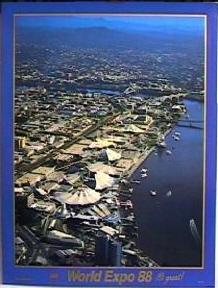
Image Source - World Expo '88 Official Poster

Image Source - World Expo '88 Official Poster
A
view of the Expo site along the beautiful
Brisbane River - looking towards Mt. Cooth-tha.
The Queensland Rail CityTrain rail corridor runs
to the west - and serviced two train stations at
the Expo's edge. The popular Victoria Bridge -
connecting the site and South Brisbane with the
centre of the City is the first Bridge in the
back right of the image.
A collection of parkland, low-rise residential, and light industry, the 40-hectare World Expo '88 site was located on the South Bank of the Brisbane River - directly opposite the Brisbane City Central Business District, and was bordered by the Brisbane River at it's eastern border; the Queen Victoria Bridge and Melbourne Street at it's northern border; the Queensland Rail CityTrain network South Brisbane and Vulture Street Stations, at it's western border; and the Queensland Maritime Museum, at it's southern border.
A collection of parkland, low-rise residential, and light industry, the 40-hectare World Expo '88 site was located on the South Bank of the Brisbane River - directly opposite the Brisbane City Central Business District, and was bordered by the Brisbane River at it's eastern border; the Queen Victoria Bridge and Melbourne Street at it's northern border; the Queensland Rail CityTrain network South Brisbane and Vulture Street Stations, at it's western border; and the Queensland Maritime Museum, at it's southern border.
After it's successful re-development into the World Expo '88 site, World Expo '88 played host to 36 national-level governments, 12 state/territory-level governments, 2 city-level governments, 2 multi-lateral organisations (the U.N. and the European Community), 18 community-level representations, 48 corporations, and 2 thematic pavilions.
The 36 national governments were:
Australia
Brunei Darussalam
Canada
People's Republic of China
The Cook Islands
Cyprus
Fiji
France
Federal Republic of Germany (last representation at a World Exposition)
Great Britain
Greece
The Holy See (Vatican)
Hungary
Indonesia
Italy
Japan
Kenya
Republic of Korea
Malaysia
Nepal
New Zealand
Pakistan
Papua New Guinea
Philippines
Singapore
Solomon Islands
Spain
Sri-Lanka
Switzerland
Thailand
Kingdom of Tonga
United States of America
U.S.S.R. (last representation at a World Exposition)
Western Samoa
Vanuatu
Yugoslavia
The 12 regional/state/territory governments were:
[Australia]
Queensland
New South Wales
Australian Capital Territory
Victoria
Tasmania
South Australia
Western Australia
Northern Territory
[Japan]
Saitama Prefecture (Sister-State of Queensland)
[United States of America]
Alaska
California
Hawai'i
The 2 City-level Governments were:
Kobe City, Japan (Brisbane's Sister-City)
Office of Economic Development of the City of Brisbane
The Community-level Representations were:
The Art of Central Australia Exhibit
The Communities of Australia Exhibit, incorporating
Greater Brisbane, Gold Coast/Albert Shire, Sunshine Coast, Toowoomba and the Golden West, Darling Downs/Southern Border, Whitsundays,
Gulf Savannah, Mackay, Outback Queensland, Cairns/Mulgrave, Bundaberg, Mt Isa, Sugar Coast/Burnett, Rockhampton, Magnetic North (Townsville
Region), and Lismore/Holiday Coast (NSW)
The Indigenous Communities of Queensland Exhibit, incorporating displays of visual and performing arts of Queensland and Torres Strait Islander culture
The 2 multi-lateral organisations were:
The United Nations
The European Community
The 48 Corporate Participants were:
[* indicates Pavilion]
[> indicates shared Pavilion]
[! indicates Sponsor of Exposition Entertainment or Services]
[^ indicates open air exhibit]
! A.N.A. Japan - Expo South Monorail Station, and one of the four Expo Monorails
> The Australian Airlines Exhibit (The Plaza)
! Australian Consolidated Press Limited - "The Bulletin Executive Club, at World Expo '88"
> The Australian Opal Mining Showcase Exhibit
* The Australia Post Pavilion
! The BP Australia Water Ski Spectacular
* The Cadbury Confectionary Pavilion
! C. Itoh & Co (Australia) Ltd - The Vulture Street Gates
> Comet Express - TNT (The Plaza)
! Conrad International Hotel
! The 'FM-104' RiverStage Control Centre - Riverstage Entertainment and laser shows
* The Ford Pavilion
! Fosters Australia Ltd. - one of the four Expo Monorails
! Fuji Photo Film Co Pty Ltd (Hanimex Pty Ltd) - official supplier of film and cameras - three (3) on-site 1 Hr Mini-labs, as well as the Photographic Media Centre.
* The Fujitsu Pavilion
> Hitachi Ltd (Japan Technoplaza)
! Iberian Airlines of Spain - sponsor of one of the four Expo Monorails
* The IBM Pavilion
> Idemitsu Kosan Co Ltd (Japan Technoplaza)
> The India Centre (The Plaza)
* The Japan External Trade Organization (The Japan Technoplaza)
! Johnson & Johnson Australia Pty Ltd
> Leisure Development Centre of Japan (Japan Technoplaza)
> Lions Service Club (The Service Clubs of Australia Pavilion - located at Entertainment House)
> LITS Tour and Travel Centre (The Plaza)
> Mater Misericordiae Hospital (The Plaza)
! Metropolitan Permanent Building Society
> The National Campaign Against Drug Abuse 'The Drug Offensive' (The Plaza)
^ The NASA Exhibit - featuring large-scale models of the Apollo Missions, and the Space Shuttle
* The Pavilion of Promise
! The QANTAS Light Fantastic Night Parade (daily at 6.30 p.m.)
* The Queensland Maritime Museum Pavilion
* The Queensland Newspapers Pavilion
* The Queensland Teachers Credit Union Pavilion
> Quota Service Club (The Service Clubs of Australia Pavilion - located at Entertainment House)
! Ray White Real Estate Ltd., sponsor of the Expo North (Melbourne Street) Monorail Station
> Rotary Service Club (The Service Clubs of Australia Pavilion - located at Entertainment House)
> The Royal Australasian College of Surgeons Exhibit 'Surgery: The Art' (The Plaza)
* The 'Silo in the City' - Primary Industries Pavilion
^ The 'Sensus' Play Area - sponsored by Suncorp Building Society
* The Suncorp Pavilion
! Syme Electronic Communications Pty Ltd (AAV Australia)
! Telecom Australia 'Expo Info' booths - over 50 booths located throughout the Expo site, with easily recognizable balloons and several interactive screen terminals
* The Univations Pavilion (Universities of Queensland)
^ The Universal Studios Exhibit - featuring the car 'KITT' from the TV series 'Knight Rider'
* The TV0 Pavilion - Network 10 Australia - Universal Telecasters
! Westpac Banking Corporation - banking facilities and foreign exchange; Sponsor of one of the four Expo Monorails
> Zonta Service Club (The Service Clubs of Australia Pavilion - located at Entertainment House)
The 2 Thematic Pavilions were:
Captain Cook, Navigator
The Magna Carta Pavilion
World
Expo '88 was open every day from 10:00 A.M. to
10:00 P.M. from Saturday April 30 1988 - the day
of the official Opening Ceremony, until Sunday
30 October 1988 - the day of the official
Closing Ceremony - a total of 185 days.
World Expo '88 was officially opened by Her Majesty Queen Elizabeth II, in the presence of the Rt Hon R.J.L. Hawke, Prime Minister of the Commonwealth of Australia; the Hon Mike Ahern, MP, Premier of the State of Queensland; the Rt Hon Alderman Sally-Ann Atkinson, Lord Mayor of Brisbane; His Excellency Monsieur Jacques Sol-Rolland, President of the Bureau International des Expositions, Paris; the Hon Sir Edward Williams, KCMG, KBE, Commissioner-General of World Expo '88; the Hon Sir Llewellyn Edwards, Chair & CEO of World Expo '88, and several thousand other VIP and invited guests at the World Expo '88 Riverstage.
The total projected attendance figure for World Expo '88 was 7.8 million persons - a figure that was achieved only three months into the Expo. Total final attendance for the six months of the Exposition - including VIPs and staff was 18, 560, 447 - more than double the original estimate and approximately the equivalent of the population of Australia at the time.
The average daily attendance figure was 100, 948.
The highest single day attendance figure at the Exposition was 182, 762 persons on Saturday 29 October 1988 - the penultimate day of the Exposition. This represents approximately a fifth of the population of Brisbane at the time.
Of non-staff visits to World Expo '88 (a total of 16, 465, 000 persons), survey results indicate that:
(i) approximately 65.4% were visits by local residents (of South-East Queensland) on day trips;
(ii) approximately 23.2% were visits by interstate visitors on overnight trips;
(iii) approximately 6.1% were visits by Queensland residents on overnight trips;
(iv) approximately 5.3% were made by overseas visitors (also on overnight trips).
Day trip visitors made an approximate 6.74 visits to the Exposition - as opposed to an average of 2.1 visits per overnight visitor.
World Expo '88 was a $AUD 625 million event. It was the first 'free enterprise' exposition - fully-self funded through sponsorship, ticket revenue, merchandise and post-expo re-development - at no expense to the tax payer - and was the largest celebration of the Bicentennial Year and the largest event in Australia's history.
Approximate figures for the chief areas of expenditure were:
$AUD 80 million was spent on acquiring the site
$AUD 130 million was spent on developing the site
$AUD 200 million was spent by exhibitors (i.e. national, corporate etc.) for their own Pavilions and exhibits
$AUD 40 million was spent on Art
$AUD 40 million was spent on Entertainment
$AUD 9 million was spent on landscaping
$AUD 40 million was spent on operating costs
The largest Pavilion was the Australia Pavilion, at 4848 square metres - costing $AUD 18 million
The most expensive Pavilion was the Japan Pavilion, at $AUD 26 million (2176 square metres)
The Opening Ceremony of the Exposition - which night-time peformance famously included 36 tap-dancers on a pink submarine coming down the Brisbane River - cost $AUD 1.5 million and involved 9, 000 staff.
World Expo '88 brought an estimated additional $AUD 630 million dollars in expenditure to the Queensland economy - principally through on-site and off-site spending in the form of accommodation, transport, food & beverages, shopping and other expenditure.
Tickets of entry to the Exposition included entrance to all Pavilions, exhibits and displays, on-site entertainment, and unlimited use of the monorail. This also included entrance to World Expo Park, however rides were charged on a pay-per-ride basis.
Ticket categories and charges were -
Season Pass: Unlimited admission during the six months of the Expo. Adult $160.00. Child/Pensioner $95.00.
Three-Day Ticket: Admission on any three days. Adult $55.00. Child/Pensioner $35.00.
Day Ticket: Admission on any one day. Adult $25.00. Child/Pensioner $15.00.
Evening Ticket: Admission on any evening after 5.00 P.M. Adult $14.00. Child/Pensioner $10.00.
Discounts were given for pre-purchased tickets before the start of the Exposition.
The Australian Commonwealth Government was represented at the Exposition - in matters relating to Protocol and all other matters regarding the Exposition - by the Office of the Commissioner General of World Expo '88 - led by Commissioner- General, the Hon Sir Edward Williams, KCMG, KBE.
The World Expo 88 Authority was responsible for organizing and implementing the Exposition itself. The Authority's official title was the "Brisbane Exposition and South Bank Redevelopment Authority". The Hon Sir Llewellyn Edwards, AC, was Chair and CEO. Members of the Board were: Sir Sydney Schubert, Deputy Chair, Mr W.J. Baker, Mr K.J. Driscoll CBE, Sir Leo Hielscher, Mr A. Bunn, Mr F.G. Maybury, and Mr J.B. Reid AO. General Manager of the Authority was Mr R.N. Minnikin MBE. The Authority had eight working divisions, each led by a Director, directly overseeing some 1,300 staff.
World Expo '88 was officially opened by Her Majesty Queen Elizabeth II, in the presence of the Rt Hon R.J.L. Hawke, Prime Minister of the Commonwealth of Australia; the Hon Mike Ahern, MP, Premier of the State of Queensland; the Rt Hon Alderman Sally-Ann Atkinson, Lord Mayor of Brisbane; His Excellency Monsieur Jacques Sol-Rolland, President of the Bureau International des Expositions, Paris; the Hon Sir Edward Williams, KCMG, KBE, Commissioner-General of World Expo '88; the Hon Sir Llewellyn Edwards, Chair & CEO of World Expo '88, and several thousand other VIP and invited guests at the World Expo '88 Riverstage.
The total projected attendance figure for World Expo '88 was 7.8 million persons - a figure that was achieved only three months into the Expo. Total final attendance for the six months of the Exposition - including VIPs and staff was 18, 560, 447 - more than double the original estimate and approximately the equivalent of the population of Australia at the time.
The average daily attendance figure was 100, 948.
The highest single day attendance figure at the Exposition was 182, 762 persons on Saturday 29 October 1988 - the penultimate day of the Exposition. This represents approximately a fifth of the population of Brisbane at the time.
Of non-staff visits to World Expo '88 (a total of 16, 465, 000 persons), survey results indicate that:
(i) approximately 65.4% were visits by local residents (of South-East Queensland) on day trips;
(ii) approximately 23.2% were visits by interstate visitors on overnight trips;
(iii) approximately 6.1% were visits by Queensland residents on overnight trips;
(iv) approximately 5.3% were made by overseas visitors (also on overnight trips).
Day trip visitors made an approximate 6.74 visits to the Exposition - as opposed to an average of 2.1 visits per overnight visitor.
World Expo '88 was a $AUD 625 million event. It was the first 'free enterprise' exposition - fully-self funded through sponsorship, ticket revenue, merchandise and post-expo re-development - at no expense to the tax payer - and was the largest celebration of the Bicentennial Year and the largest event in Australia's history.
Approximate figures for the chief areas of expenditure were:
$AUD 80 million was spent on acquiring the site
$AUD 130 million was spent on developing the site
$AUD 200 million was spent by exhibitors (i.e. national, corporate etc.) for their own Pavilions and exhibits
$AUD 40 million was spent on Art
$AUD 40 million was spent on Entertainment
$AUD 9 million was spent on landscaping
$AUD 40 million was spent on operating costs
The largest Pavilion was the Australia Pavilion, at 4848 square metres - costing $AUD 18 million
The most expensive Pavilion was the Japan Pavilion, at $AUD 26 million (2176 square metres)
The Opening Ceremony of the Exposition - which night-time peformance famously included 36 tap-dancers on a pink submarine coming down the Brisbane River - cost $AUD 1.5 million and involved 9, 000 staff.
World Expo '88 brought an estimated additional $AUD 630 million dollars in expenditure to the Queensland economy - principally through on-site and off-site spending in the form of accommodation, transport, food & beverages, shopping and other expenditure.
Tickets of entry to the Exposition included entrance to all Pavilions, exhibits and displays, on-site entertainment, and unlimited use of the monorail. This also included entrance to World Expo Park, however rides were charged on a pay-per-ride basis.
Ticket categories and charges were -
Season Pass: Unlimited admission during the six months of the Expo. Adult $160.00. Child/Pensioner $95.00.
Three-Day Ticket: Admission on any three days. Adult $55.00. Child/Pensioner $35.00.
Day Ticket: Admission on any one day. Adult $25.00. Child/Pensioner $15.00.
Evening Ticket: Admission on any evening after 5.00 P.M. Adult $14.00. Child/Pensioner $10.00.
Discounts were given for pre-purchased tickets before the start of the Exposition.
The Australian Commonwealth Government was represented at the Exposition - in matters relating to Protocol and all other matters regarding the Exposition - by the Office of the Commissioner General of World Expo '88 - led by Commissioner- General, the Hon Sir Edward Williams, KCMG, KBE.
The World Expo 88 Authority was responsible for organizing and implementing the Exposition itself. The Authority's official title was the "Brisbane Exposition and South Bank Redevelopment Authority". The Hon Sir Llewellyn Edwards, AC, was Chair and CEO. Members of the Board were: Sir Sydney Schubert, Deputy Chair, Mr W.J. Baker, Mr K.J. Driscoll CBE, Sir Leo Hielscher, Mr A. Bunn, Mr F.G. Maybury, and Mr J.B. Reid AO. General Manager of the Authority was Mr R.N. Minnikin MBE. The Authority had eight working divisions, each led by a Director, directly overseeing some 1,300 staff.

The popular and
attentive World Expo '88 Authority - with Expo
sunsails in the background
Image Courtesy
and Copyright Australian Consolidated Press
and Russell Stokes
Directors, Chair
& CEO, and the General Manager [FRONT L-R]
Communications (Jane Brumfield), General Manager (R.N.Minnikin), Operations (Ross Given), International Participation (Richard John)
[BACK L-R] Entertainment (Ric Birch), Marketing (Graham Currie), Finance & Administration (Tony Phillips), Chair and CEO (Sir Llewellwyn Edwards),
Site Development (Peter Goldston) and Technology (Ken Pope).
Communications (Jane Brumfield), General Manager (R.N.Minnikin), Operations (Ross Given), International Participation (Richard John)
[BACK L-R] Entertainment (Ric Birch), Marketing (Graham Currie), Finance & Administration (Tony Phillips), Chair and CEO (Sir Llewellwyn Edwards),
Site Development (Peter Goldston) and Technology (Ken Pope).
A total of 24, 000 persons were accredited by World Expo '88.
Question 10. How can I help Foundation Expo '88?
Attend one of our bi-annual meetings - held on the anniversary days of the opening and closing ceremonies - 30 April and 30 October.
Write a passage about your day at World Expo '88. What can you remember? What was your favourite pavilion? What was your most memorable experience?
Send a copy of some of your favourite Expo '88 photographs for addition on the Foundation 'Photos' and 'Pavilions' pages.
Suggested Further Reading - References
Bureau of International Exhibitions, https://www.bie-paris.org (26 October 2005)
Commssioner General's Report, Report of the Commissioner General of Expo 88 on the Australian Government's Involvement in Expo 88 (1988), Commissioner General of Expo 88. Digitised at the Academic Forum.
Crystal Palace Foundation, https://www.crystalpalacefoundation.org.uk (26 October 2005)
Expo! an independent Review (1988), Scott Jones, David Bray, Juanita Phillips [Authors], Boolarong Publications
Expo Down Under (1987-1988), monthly official newsletter of the Communications Division, World Expo '88 Authority, World Expo '88
Expo Excitement (1988), Louise Egerton [Editor], Event Publishing - A Division of Australian Consolidated Press
"Expo 88 impact : the impact of World Expo 88 on Queensland's Tourism Industry", Queensland Tourist and Travel Corporation and the National Centre for Studies in Travel & Tourism (1988), James Cook University. Digitised at the Academic Forum.
expomuseum.com, Urso S. A. Chappell [Editor/Webmaster] (26 October 2005)
EXPOSICIONES UNIVERSALES - El Mundo en Sevilla, Luis Calvo Teixeira [Author], Editorial Labor S.A., rtve, Expo '92 Sevilla, Printed in Barcelona.
Expo Today (1988), daily entertainment report of The Courier Mail, Queensland Newspapers Brisbane. Digitised at Expo Today.
The Human Factor of World Expo '88, Australian Print Brokers, West End Brisbane.
Master of the Ceremonies : an eventful life (2004), Ric Birch [Author], Allen & Unwin
The Melbourne Royal Exhibition Building, Museum Victoria, https://www.museum.vic.gov.au/reb/ (21 Nov 2005)
A Multitude of Spectacles - Hungary's Role in the History of World Exhibitions, György Diószegi - József Gáti (1992), Dr Tamás Kolosi Publisher, B+V Publishing House, Budapest
Opening Ceremony Speeches, National Day Speeches, Closing Ceremony Speeches (1988), Commissioner General of Expo 88. Digitised at the Academic Forum
"The Origins of Expo '88" (1988), Peter Carroll [Author], Australian Journal of Public Administration, Vol. 48 No. 1, March 1989. Digitised at the Academic Forum.
Plan souvenir officiel Expo 67 - Official Souvenir Map Expo 67 (1967), Maclean-Hunter Publishing Company, Canada
The Rainbow Serpent (1988), Oodgeroo Noonuccal and Kabul Oodgeroo Noonuccal [Authors], Australian Government Publishing Service, Canberra
Royal Exhibition Building and Carlton Gardens, UNESCO World Heritage, httpss://whc.unesco.org/en/documents/189109 (accessed 2 March 2024)
Showing Off: Queensland at World Expositions 1862-1988 (2004), Dr Judith McKay [Author], Central Queensland University Press & The Queensland Museum
Study on the Impact of International Expositions (1996), Claude Servant and Ippei Takeda [Authors], Bureau International des Expositions - Service de Documentation - série << Etudes >> 1,
That's Entertainment - World Expo '88 (1988), Brett Cochrane [Photographer] et al., Brett Cochrane Productions. Published by Brett Cochrane.
THIS WAS expo (1968), Robert Fulford [Author], Stewart & McLelland Limited Publishers, Toronto
The World's Columbian Exposition - A Centennial Bibliographic Guide (1996), David J. Bertuca [Senior Compiler], Donald K. Hartman, Susan M. Neumeister [co-compilers]
World Expo 88: Brisbane - Australia April 30 - October 30, 1988 (1988), Robert Brown & Associates (Aust) Pty. Ltd.
World Expo 88 Landscape (1988), Lawrie Smith [Author], Landplan Studio, Australian Print Brokers, Printcraft, Brisbane.
World Expo '88 The Official Souvenir Program (1988), Australian Consolidated Press
World Expo '88 Orientation Handbook (1988), World Expo '88 Authority, World Expo '88
World Expo '88 Passport (1988), official commemorative passport for the 1988 World Exposition, World Expo '88
World Expo 88 Report, The Courier Mail (1988), Queensland Newspapers Brisbane
World's Fair Magazine (1981-1995 published quarterly), Alfred Heller [Editor], Corte Madera, California. Note entry in Academic Forum
World's Fairs (1998), Erik Mattie [Author], Princeton Architectural Press
Zaragoza Expo 2008, https://www.zaragozaexpo2008.es (26 October 2005)